MOUNT ATHOS (Athos 2033 m)
I would like to start a story, about Holy Mount Athos, with the words of great Serbian Bishop Nikolai Velimirovic: Mount Athos is the kingdom without a crown, country without an army, wealth without money, wisdom without school; a place where people dies, and no one get born. Mount Athos is considered to be the first, of four parts in the universe, of Mother of God. Other three are Georgia, the Kiev – Pecherska Lavra monastery (in Ukraine) and monastery Diveevo (in Russia). Paradox is that the Holy Mountain is prohibited for women, although it is dedicated to the Virgin Mary. You can feel a great boon, at this holy place. Those who not believe, they’ll believe, and those who are believers, they will strengthen their faith. The process of obtaining a visa, for the Holy Mountain, is pretty easy. You have to call, or send an email, and reserve a date of entry at the Mount Athos. All necessary information can be found at the following web sites:
http://thessaloniki.pbworks.com/w/page/22156781/Visiting % 20Athos
It is necessary, to send the passport number and the date of entry, at athosreservation@gmail.com. The answer will come soon, in a day or two. Visa is called Diamonitirion and costs 25 €. You can get it in Thessaloniki or Ouranoupoli. Diamonitiron is valid for four days, but you can stay much longer. It can be extended in the capital of Mount Athos, Karyes, but I do not have that experience. I do not know what happens if Athos police caught you with an expired visa. There are 20 monasteries at Mount Athos. Half of them are on the east, and the other half are on the west side of the coast. Karyes, the capital, is right in the middle of peninsula. Besides the monasteries, there are a lot of sketes. Some of them are larger than some monasteries. Skete belongs to the monastery, but do not have the status of the monastery. When you make your travel plan, you need to call, or send a fax, to the monastery in which you intend to spend the night. Overnight in monasteries is free, so is food. Lunch is in the morning, after the morning service, and dinner is after the Vespers. You can come unannounced, at the monastery, and spend the night. Every monastery should accommodate you, for one night, but you never know, times are changing. At websites, you can find phone and fax numbers. Monasteries, where you can make reservations by e-mail, are: Megiste Lavra (iera.moni.megistis.layras@gmail.com), Vatopedi (filoxenia@vatopedi.gr; monastery@vatopedi.gr), Simonopetra (hospitality@simonopetra.gr), Iviron (imiviron@gmail.com), Dionysiou (agiosnifon@gmail.com), Philotheou (philotheou.filoxenia@gmail.gr), Gregoriou (imog@cosmotemail.gr), Xenophontos (arhontariki@imxenophontos.gr), Xeropotamou (xeropotamou@yahoo.gr), Pantokrator (pantokvisit@gmail.com or filoxenia@pantokrator.gr), Dochiariou (dohiarmon@gmail.com), Koutloumousiou (imkathos@gmail.com), Agiou Pavlou (visit@agiou-pavlou.gr), Chilandar (pilgrims@hilandar.org) and Zografou (zografergo@gmail.com). E-mail of Russian monastery St. Panteleimon is rpm.palomnik@gmail.com.
Now, the trip can begin! Distance, between Belgrade and Uranopolis, is about 770 km. The route is as follows: Belgrade-Niš highway – Presevo border crossing – Macedonia – border crossing Evzoni. About 10 km before Thessaloniki, look for Halkidiki mark . Turn on the highway to Halkidiki. Next exit, from the highway, is when you spot a signpost “Agio Oros”.
When you arrive at Ouranopoli, drive along the main road, to the tower, which is on the right side of the dock. Then, drive by the main road, to the left. Another couple of hundred meters, and you will come to a large parking lot, where pilgrims parks their cars. If you want to overnight, the most convenient hotel is Xenios Zeus. Room for three persons costs 50 €. All information, about the hotel, you can found at:
http://www.ouranoupoli.com/zeus/.
The hotel is located at the second street on the left. This is a picture of the hotel, with the stone wheel in front:
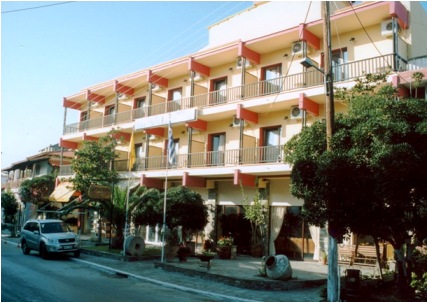
At 7:00, be in front of the pilgrims office, where you have to collect Diamonitirion. The office is located 50 meters from the hotel, in the direction of the port. Ferry ” St. Panteleimon ” departures at 09:45. Ticket price depends on at which port you will get off. At the entrance to the ferry, you must show Diamonitirion. The ferry stops at each port of every monastery, on the way to the port Daphne. Daphne is a major Athos port. There is a couple of shops, where you can supply with food. The first port is Chilandars port Jovanica. There is a van in the port, which will take you to Chilandar, for free. While waiting for the ferry, you have enough time to visit local stores and buy a good map of the Holy Mountain, or a book about it. Our team decided to climb the highest peak of Atos on the first day, so we boarded in the speedboat ‘‘Micra Agia Anna‘‘. This speedboat departures at 08:00. First stop is Daphne; final stop is Kavsokalyvia. Speedboat arrives around 9:15, at the skete of St. Anne. At that time, we started our climb to the highest peak of Mount Athos. There is about 12 km, to the top, but you need to overcome a height difference of 2000 m, on a hot September’s sun! The trail goes up, by the stairs, and then continues on, by a macadam road.
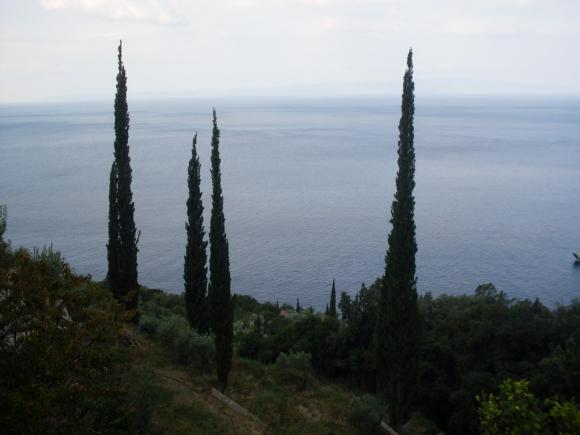
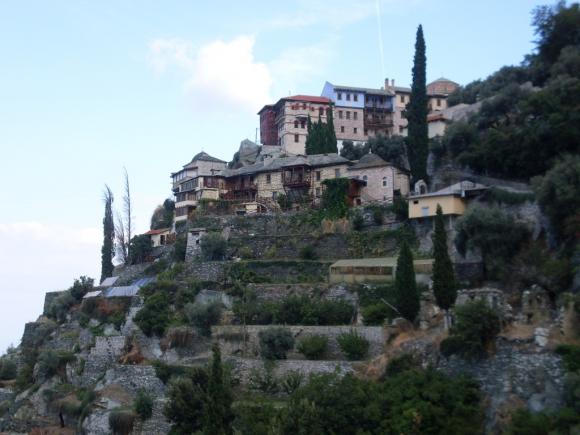
Skete of St. Anne
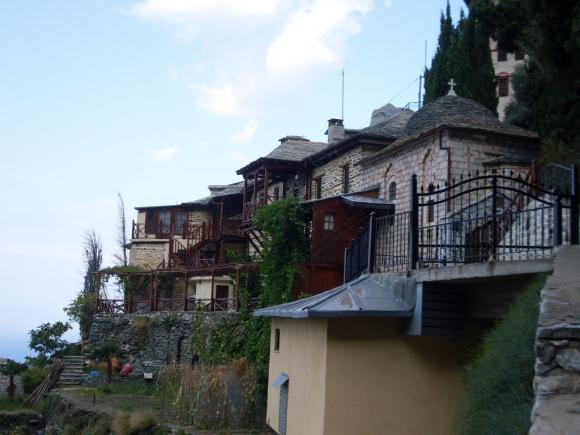
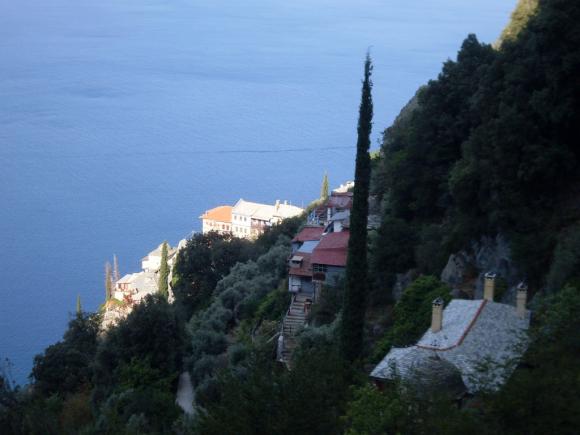
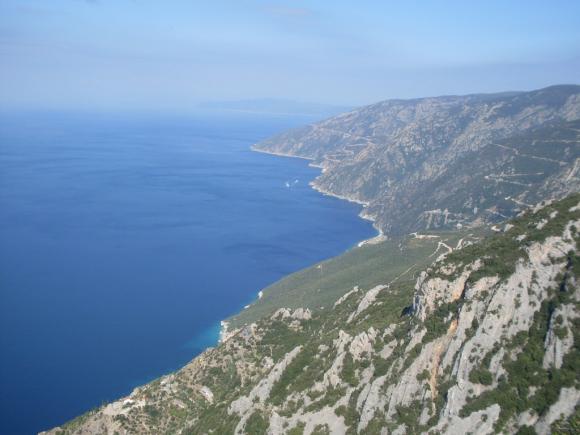
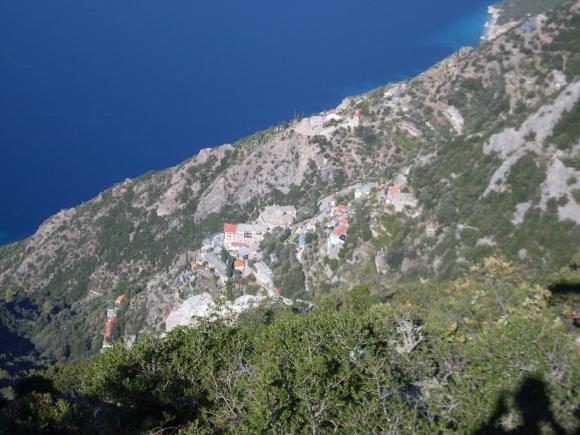
Below the top of Athos, is a chapel Panagia, at 1500 m. You can overnight inside, if you have a sleeping bag. You can climb the top and then overnight, or vice versa. The chapel has a pair of beds, in which you can sleep. If there are a lot of mountaineers and all beds are occupied, you’ll need your sleeping bag, to sleep on the floor.
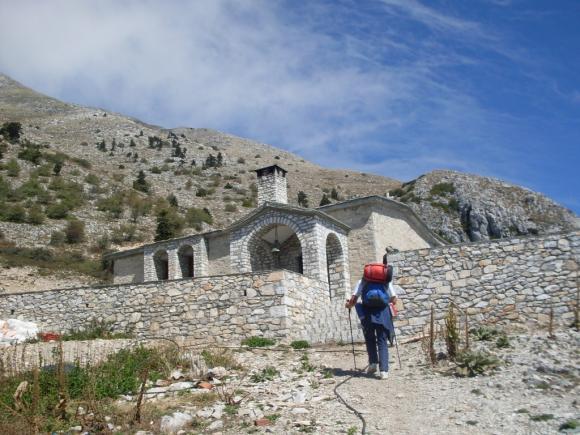
Panagia
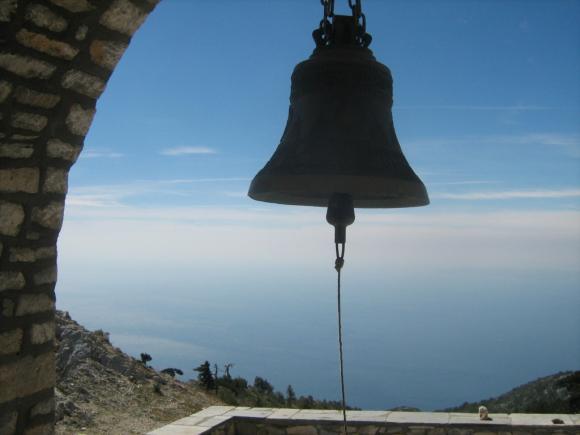

From Panagia, a rocky road leads to the top. It takes about 45 to 60 minutes, to the top. Reward is a breathtaking view, from the roof of the Holy Mountain! These 2033 meters, above sea level, seems much higher, when you look into the blue sea beneath you! The first Serb, who climbed the top of Athos, was St. Sava. That makes him the first Serbian mountaineer! At Mount Athos, monks says, that, every monk should climb the top of Athos, at least once in his life. I understand why. At this point, you are so close to God!
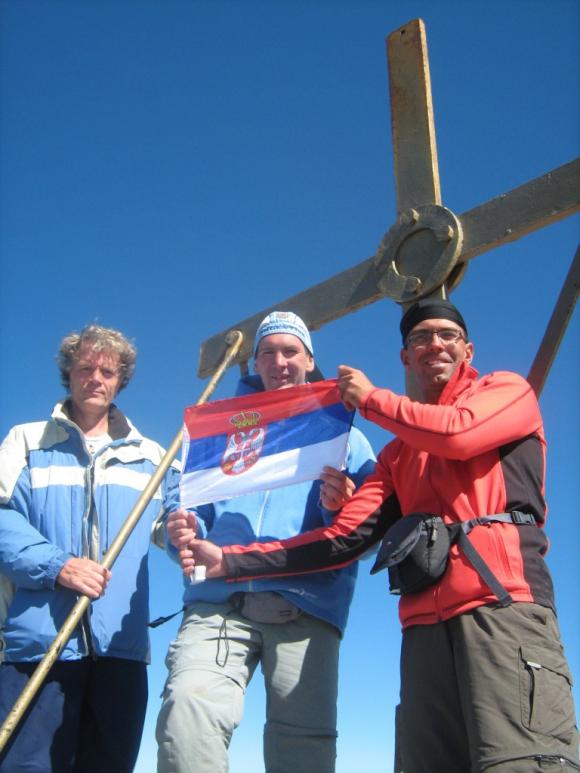
At the top of Athos
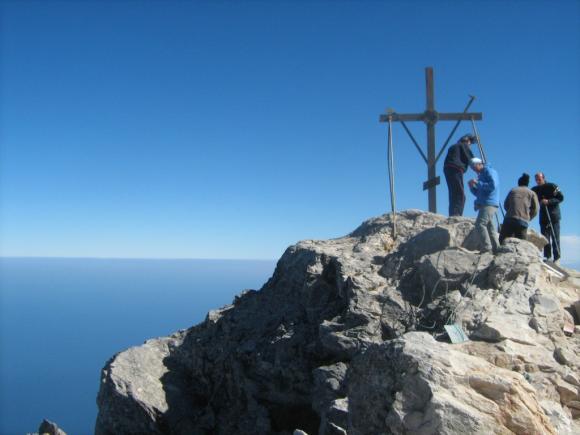
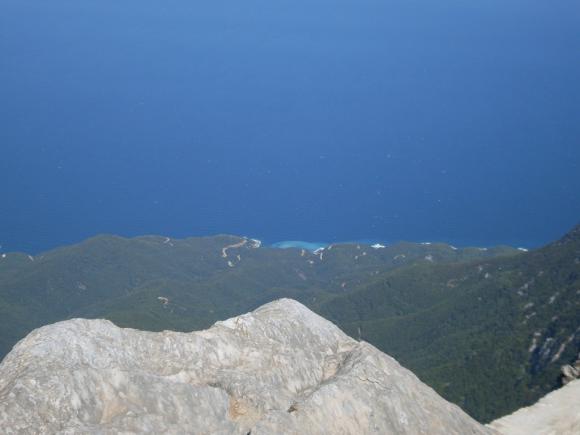

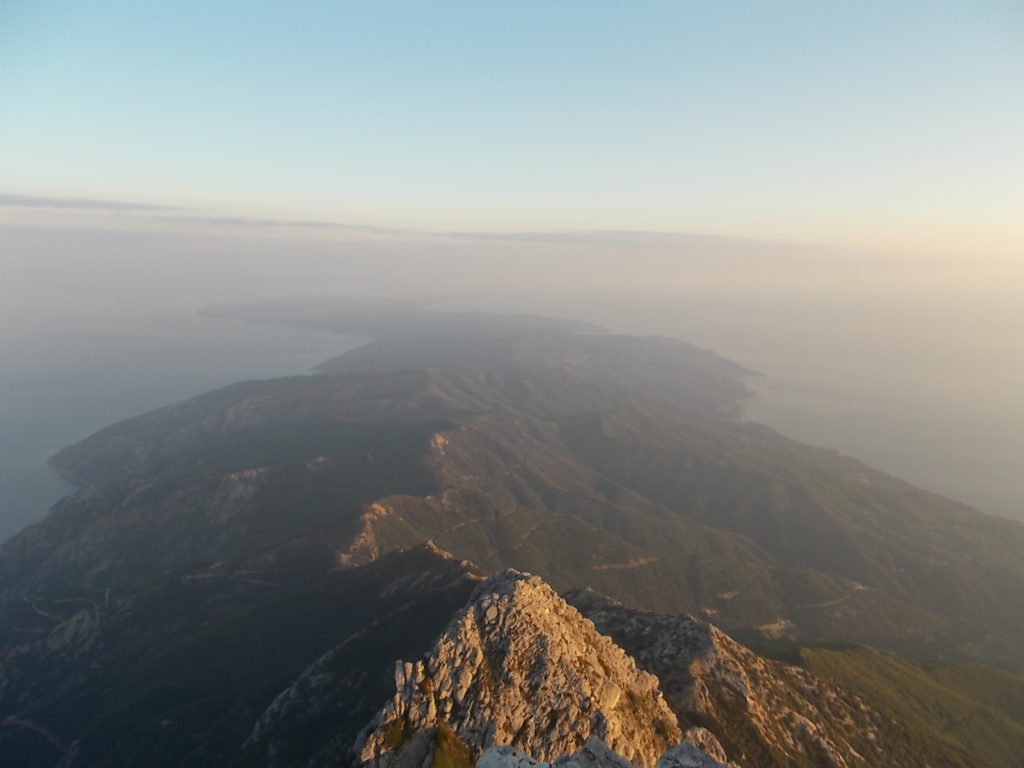
The chapel of Metamorphosis is building, at the top of Athos. Imagine that feeling, sleeping at the roof of the Holy Mountain! There was no need, for us, to overnight at Panagia. With God’s help, we went down, to the monastery of St. Paul and overnight. Around 18:00, we were at the skete of St. Anne. A left foot of St. Anne, the Virgin’s mother, is at this skete. We venerate this holy relic.
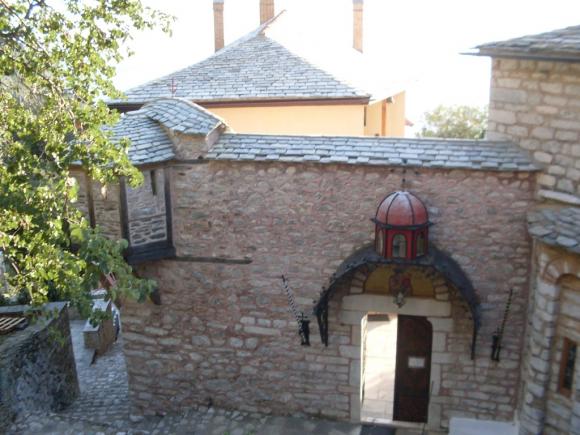
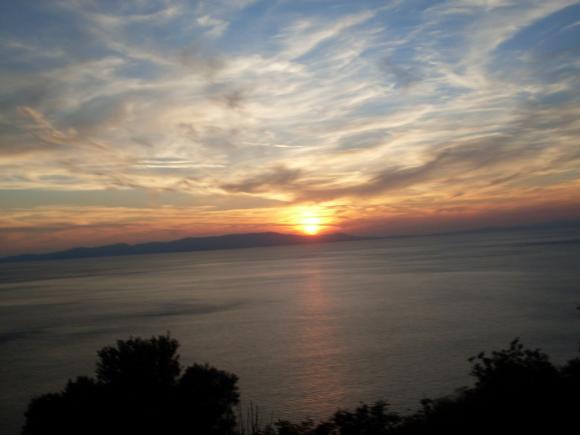
Distance between St. Anne and monastery of St. Paul, is about 45 minutes. The monastery gates closes at sunset, in this case around 20:00, so you have to be there right on time. Monastery of St. Paul is one of the biggest and most beautiful monasteries, at the Holy Mountain. In 15th century, it was financially helped by Serbian duke Djuradj Brankovic, so, the door is always open for Serbs. For almost 400 years, St. Paul was a Serbian monastery, under the dynasty of Brankovic.

Monastery of St. Paul
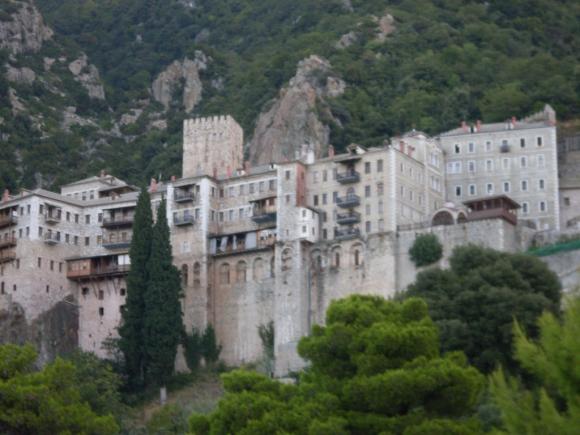
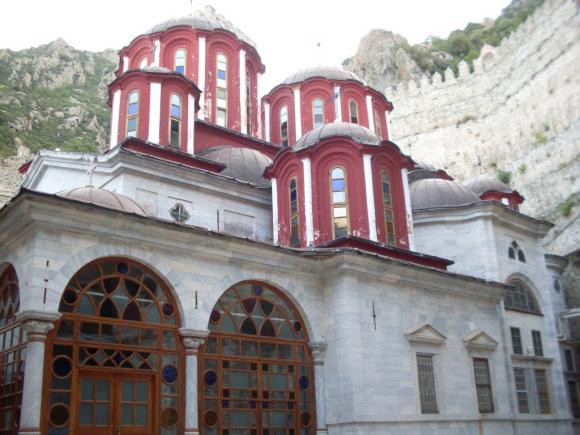
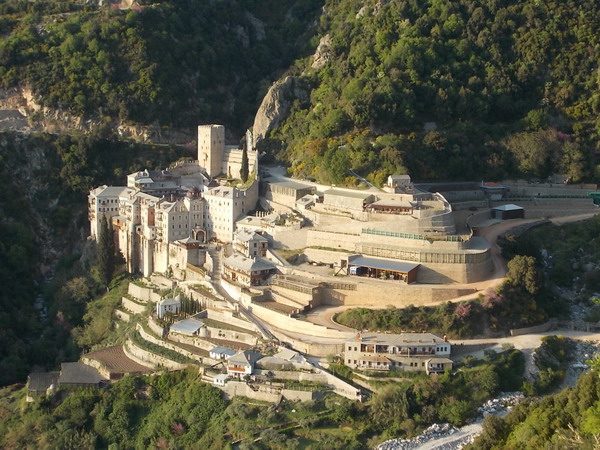
Next morning, after the service and breakfast, we continued, by foot, to Karyes, the capital of Mount Athos. Our goal was to overnight at the St. Andrew’s skete, which is located at the entrance of Karyes. West coast of Mount Athos, ie, part from St. Paul to Simonopetra, is hard for hiking, due to a frequent and strenuous climbing. After 45 minutes, we reach the monastery of Dionysiou. In the monastery, we took a break. We refreshed ourselves with Turkish delight and ouzo.
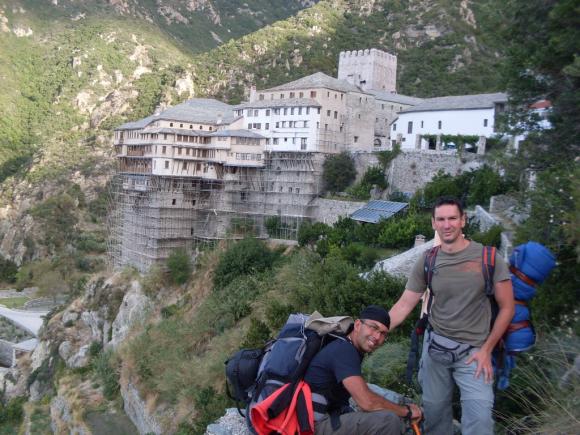
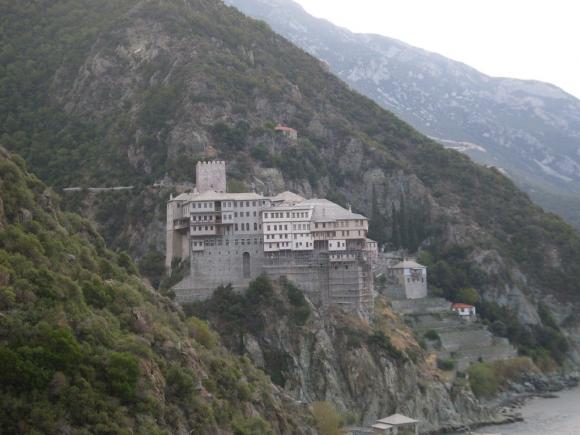
Dionysiou
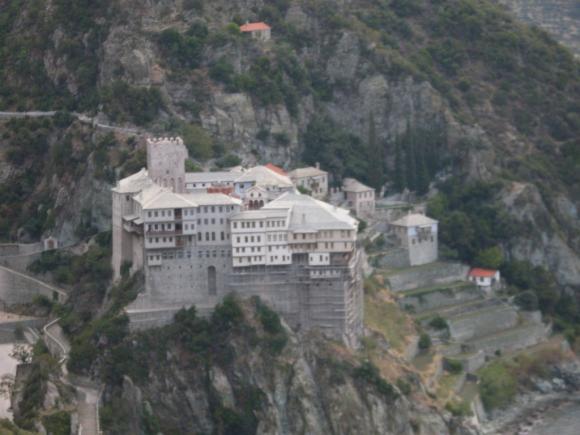
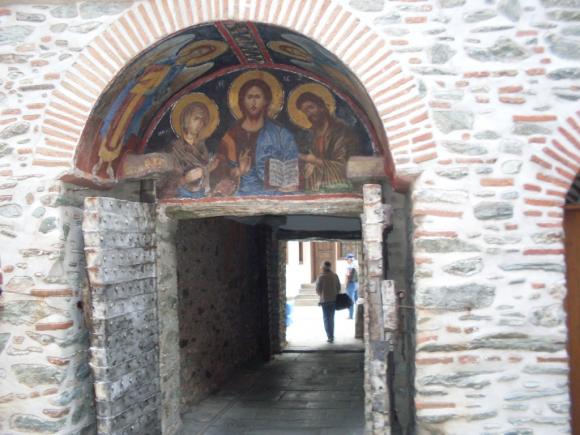
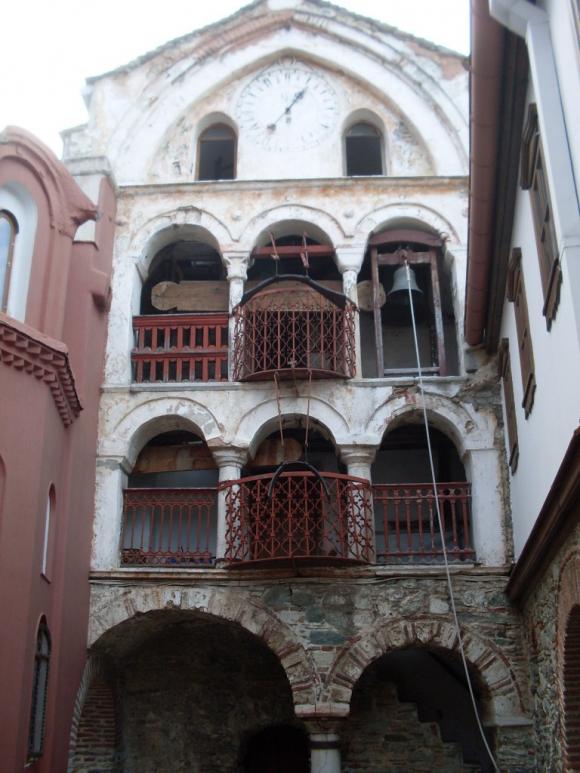
We continued toward monastery of Gregoriou. This monastery was founded by St. Gregory, in 14th century. St. Gregory is the founder of Serbian monastery Gornjak, near Petrovac, on the river Mlava, where some of his remains lies. Today, in Gregoriou lives one Serbian monk, Father Silouan. Unfortunately, he was not in the monastery, so we didn‘t have a chance to talk with him. On the terrace of the monastery, you feel like you’re on a ship, which sails slowly.

Gregoriou
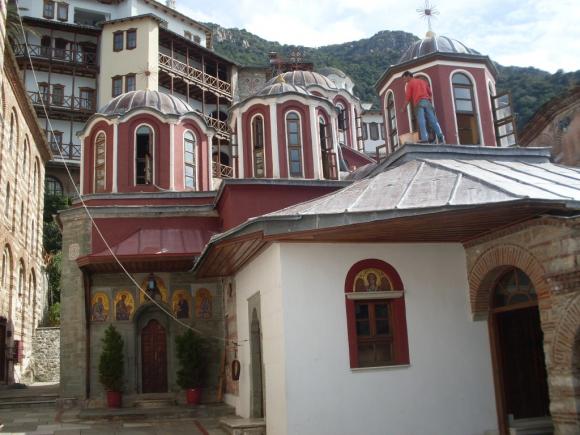

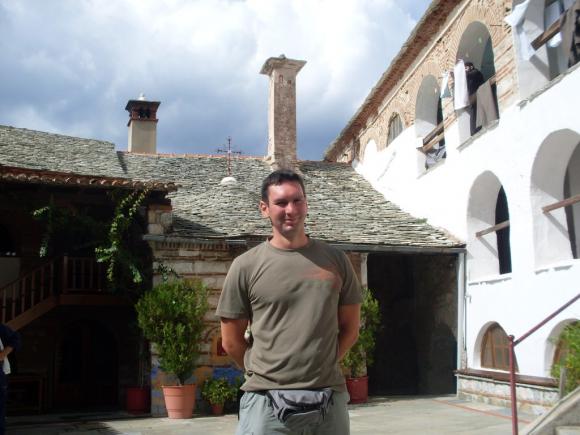
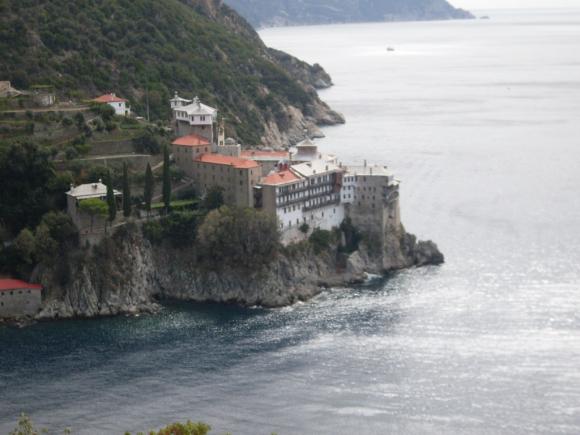
Another hour of walk, by the rocky trail, and we came to the most impressive monastery at Mount Athos – Simonopetra! I think Simonopetra is a trademark of the Holy Mountain. It looks like rocks ejected Simonopetra from its belly! I still wonder, how the architects, in the 13th century, built something like this? Even nowadays, this would be an architectural wonder. The monastery church was built around a rock. The beam fell from the sky, on that rock. That was the sign, for St. Simon, to build a monastery at this place. St. Simon lived in a cave nearby. Holy Mother appeared and told him to build a monastery, on a rock. “Petrus” means “rock”, in Greek.
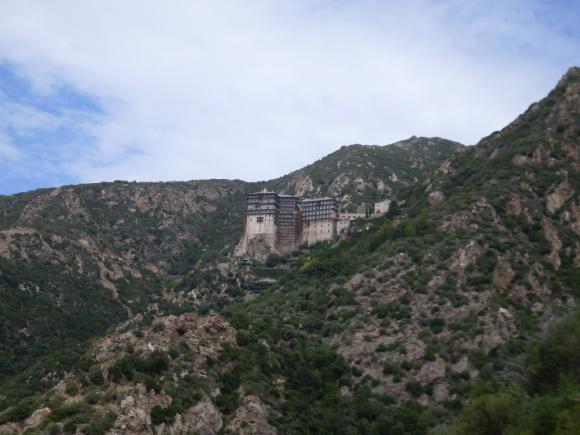
Simonopetra
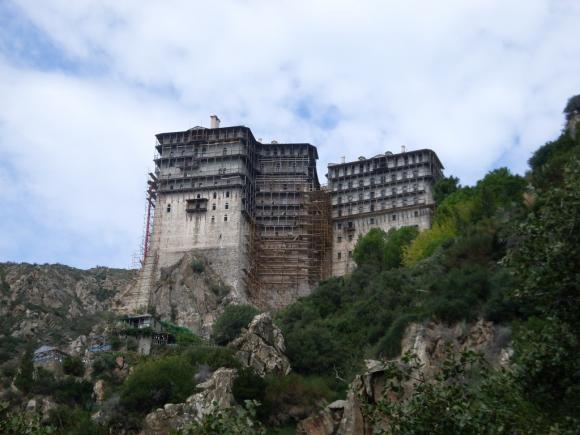
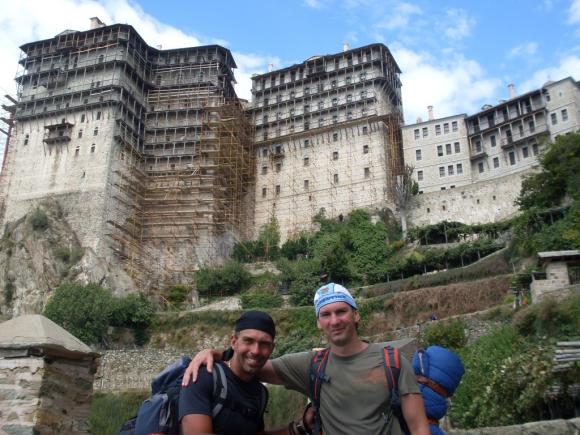
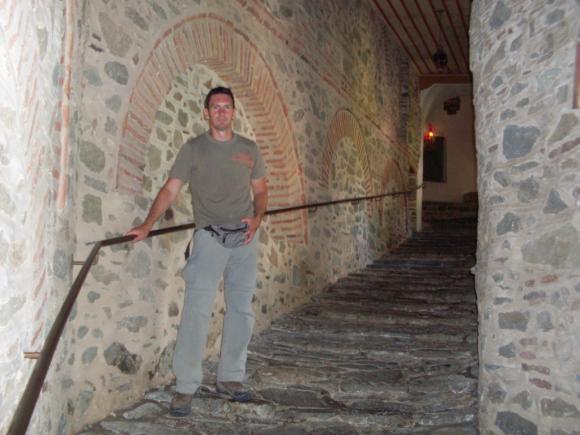
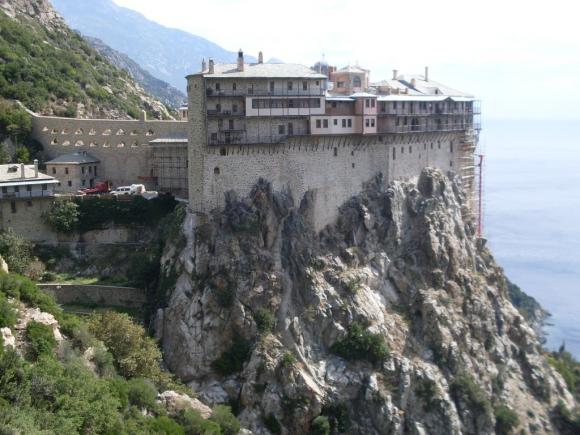
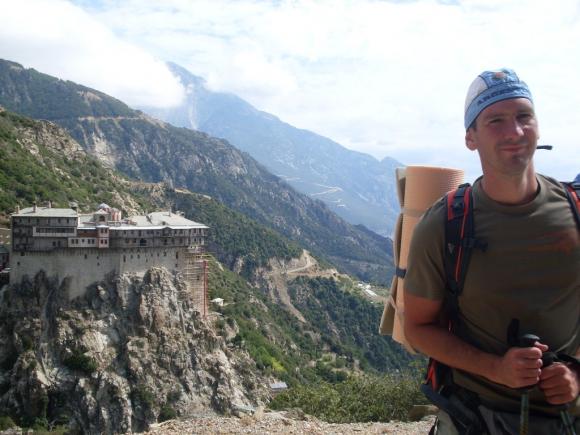
We proceeded to the port of Daphne. We were lucky and we hitched a van, which took us to the monastery of Xiropotamos, located one hour of walk from Daphne. Records of this monastery are from the fifth century. Xiropotamos owns a huge piece of the Holy Cross.
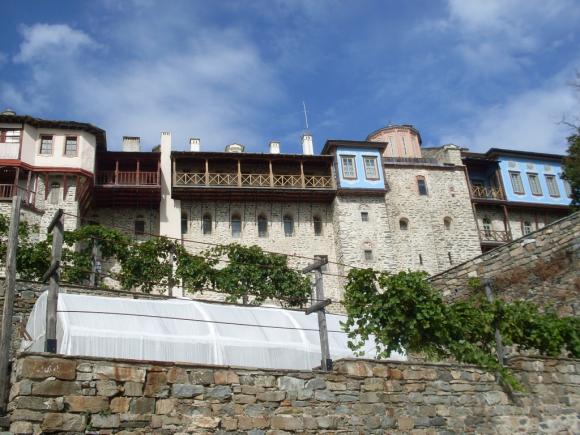

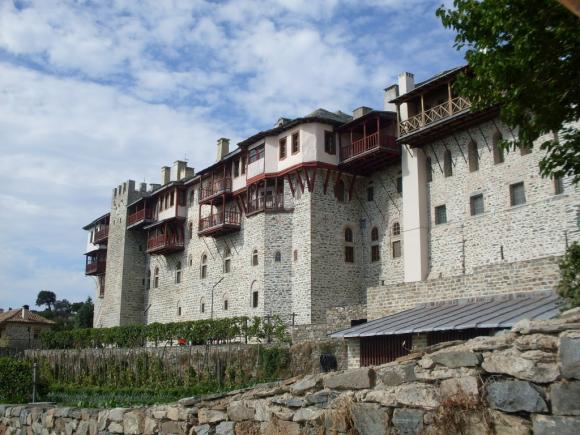
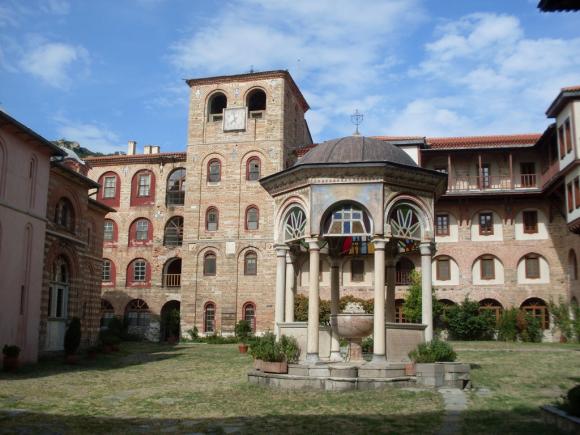
Xiropotamos
Again, God looked at us and sent a van, which transported us to the largest skete on Mount Athos, skete of St. Andrew. No way we could manage it by foot; road is too long from Daphne! Once, sketes name was Serai, because it was the seat of the Turkish authorities, during the Ottoman occupation of Mount Athos. Skete was built by the Russians. A part of it was built by Russian oligarch Sibiryakov, who later became a monk Innokenty. After the collapse of the Romanov dinasty, skete was transferred into Greek hands and now belongs to the Vatopedi monastery.
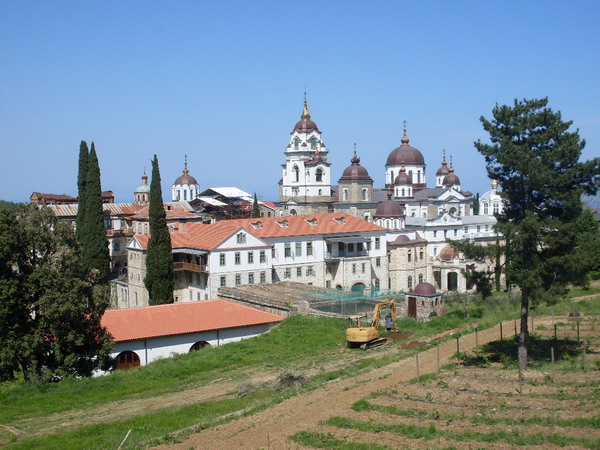
Skete of St. Andrew
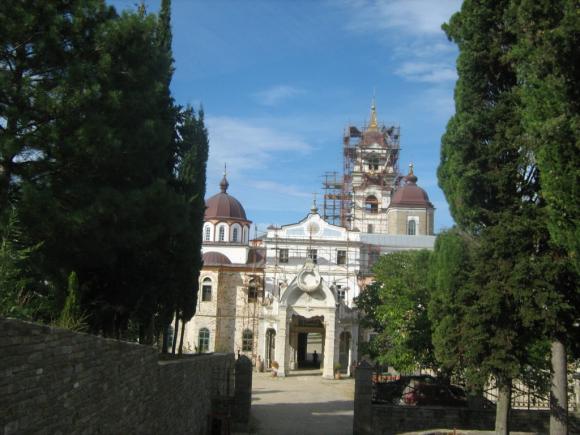
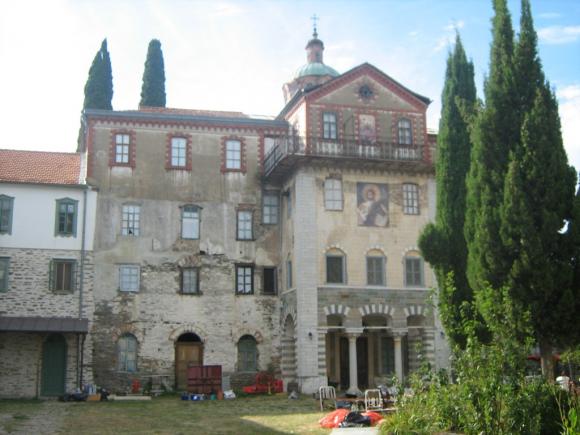
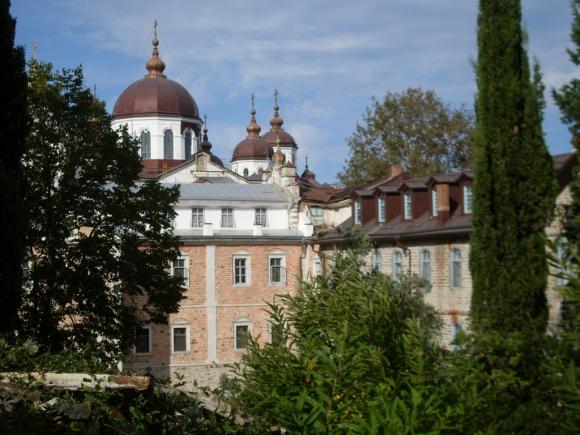
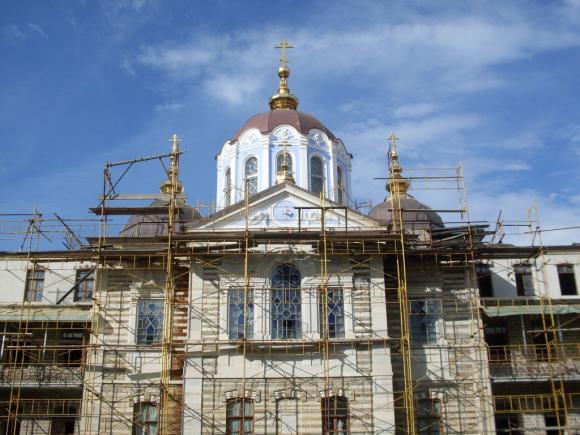
In the morning, we visited Karyes, capital city and administrative center of Mount Athos. City has a couple of stores and one restaurant. Protatos, the oldest church at the Holy Mountain, is located in Karyes. Famous icon, Axion Esti, is held at Protatos.
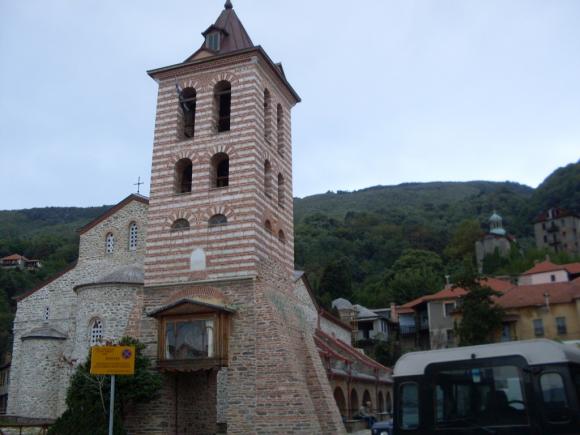
Protatos

Karyes
Hermitage of Serbian St. Sava, is located in Karyes. This is a cave, where this great Serbian saint lived. It is not easy to find it. In this hermitage, in the altar, the icon of Holy Mother is placed on the right side, instead of left. Saint Sava has changed positions of Jesus and the Holy Mother, because of his great love for Holy Mother. The name of this icon, of Holy Mother, is Galactotrofussa.
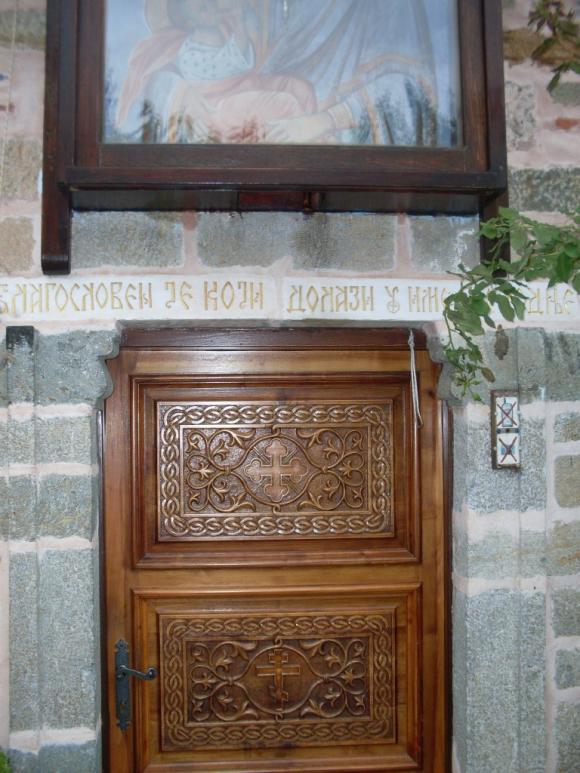
Hermitage of St. Sava
We visited Koutloumousiou monastery. There is a head of St. Alympius Cionites. Koutloumousiou is located at 15 minutes of walk, from Karyes.
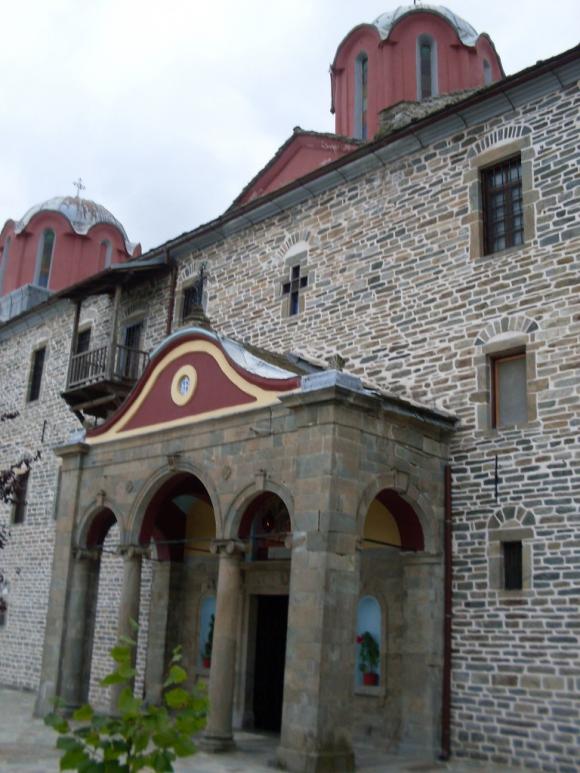
Koutloumousiou
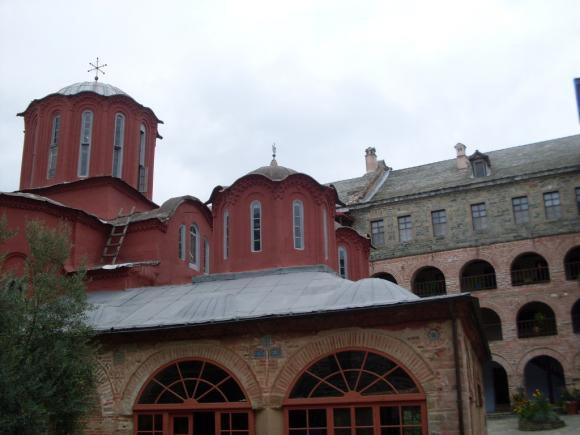
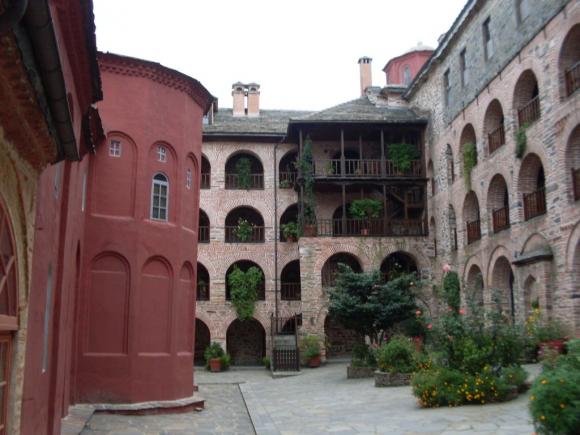
From Karyes, we continued to the east coast, which is quite easy to hike. After hour and a half, we are in front of Iviron monastery. This is the place where Holy Mother first landed, when she traveled to Cyprus, to visit resurrected Lazarus. Enthralled by the beauty of Athos, she prayed to Jesus Christ, to convert it into Her garden. From that moment, Atos is dedicated to the Mother of God.
Iviron was founded by Georgian monks, St. John and St. Efthimios, in 10th century. In the mid 19th century, the number of Georgian monks decreases and the monastery was taken over, by the Greek monks. At Iviron, one of the most famous and respected icons of Mount Athos, is kept. The icons name is “Portaitisa” (Doorkeeper). The legend says, that, when the Turks attacked the monastery, monks defended this icon with their lives. The Turks were wondering why they do it, and monks responded, that, the icon is a living creature. Then the Turk drew his sword and said: “If she’s alive, let her bleed,” and he cut the icon, across the face. Blood gushed from the icon and forced Turks to flee. Even today, there is a trace of blood at the icon. The prophecy says, that, when the icon disappears from Mount Athos, that will be the end of a Holy Mountain.
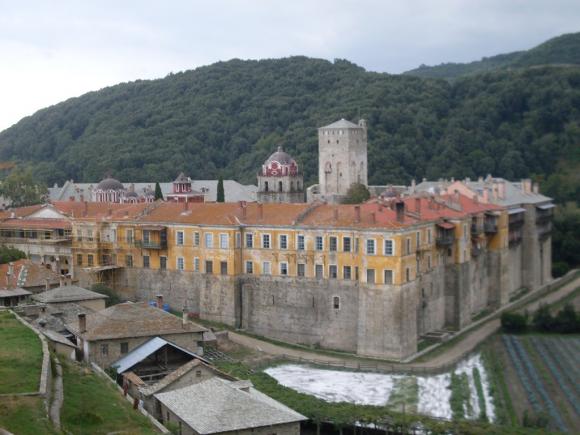
Iviron
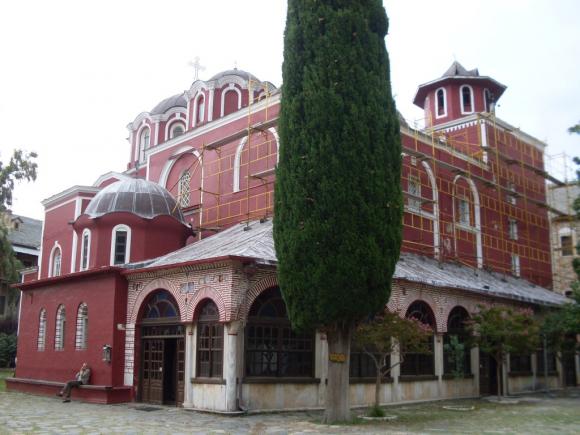
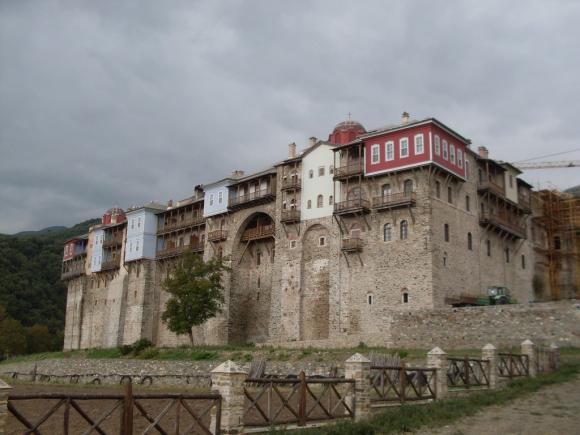
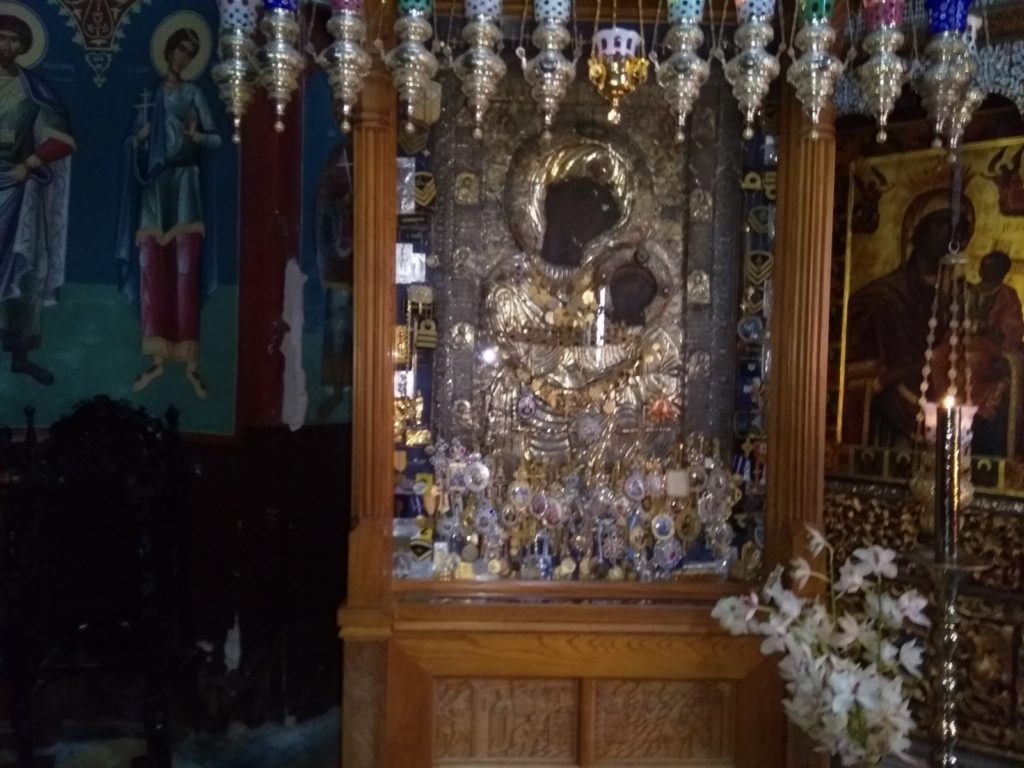
Portaitisa
We continued toward the monastery of Stavronikita, which is an hour away, from Iviron. Stavronikita is the smallest monastery at Mount Athos. It is dedicated to St. Nicholas. In the mid 16th century, fishermen pulled, from the sea, an icon of St. Nicholas. The icon was thrown into the sea 700 years earlier, by the unbelievers. The icon was pulled undamaged and the shell was stuck above the right eye of the saint. When monks pulled off the shell, blood appeared. You will see a cavity, above the eye of St. Nicholas, which was made by the shell.
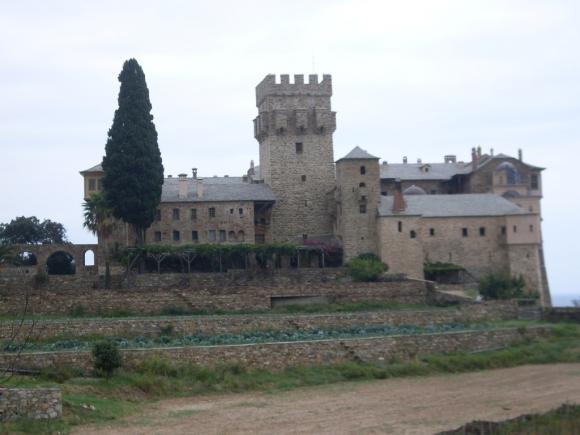
Stavronikita
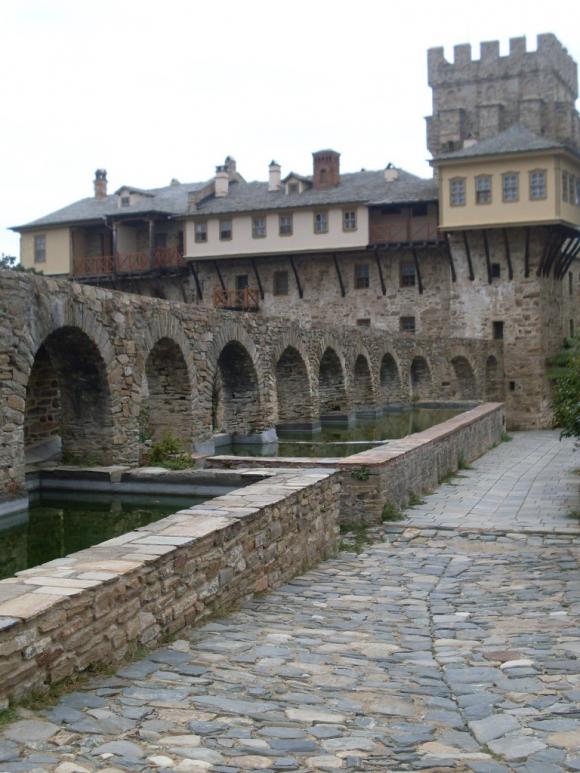
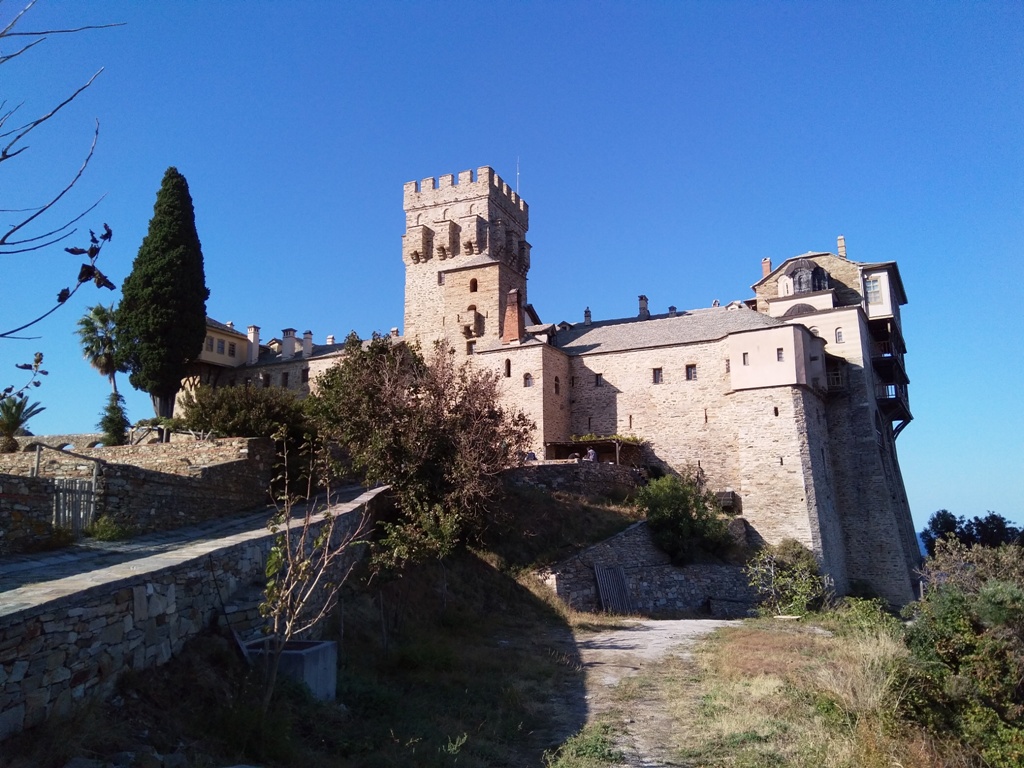

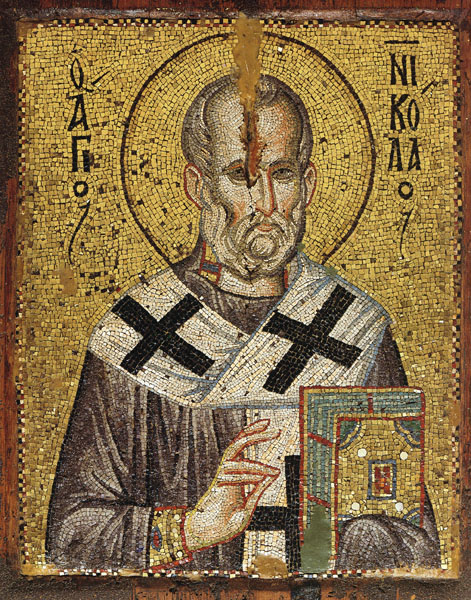
An hour of walk from Stavronikita, monastery of Pantocrator lies. It is famous for the miraculous icon of the Mother of God, called “Gerontissa”. It is believed, that this icon helps elderly and ill people, in their last moments of life. This icon represents Holy Mother in its natural size.
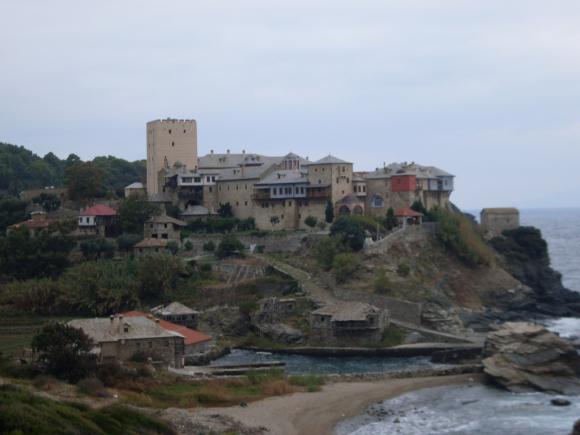
Pantocrator
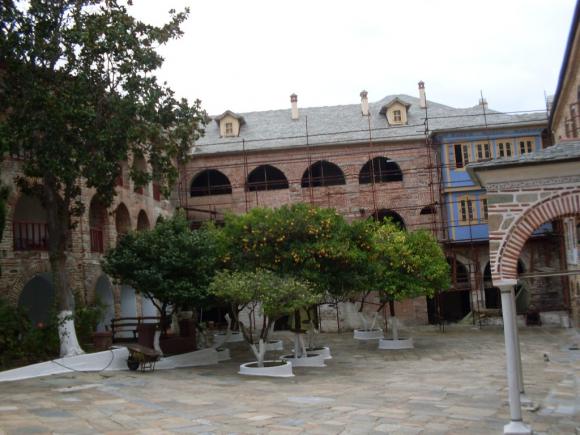
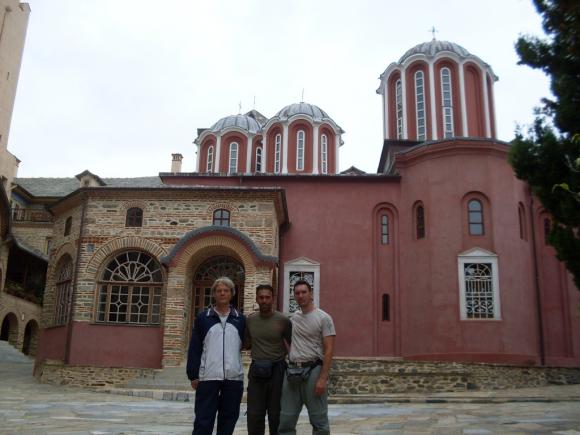
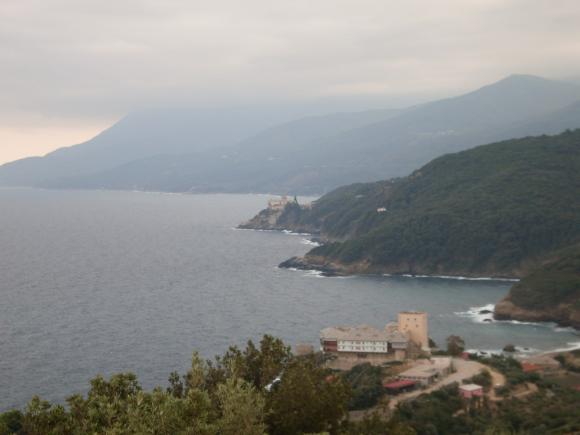
From Stavronikita, after 2,5 hour of walk, we arrived at Vatopedi. Perhaps the biggest monastery at Mount Athos, it is also known for the fact, that, Rastko Nemanjic (St. Sava of Serbia) and Stefan Nemanja (St. Simeon of Serbia) stayed in it, during the reconstruction of Chilandar monastery. The biggest relic of the monastery is the belt of Mother of God, which was donated by Serbian duke Lazar.

Vatopedi
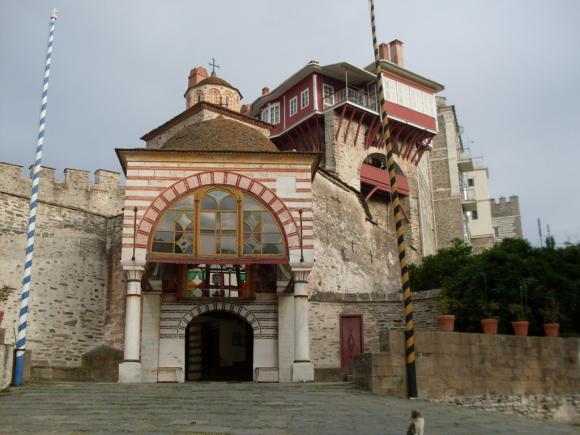

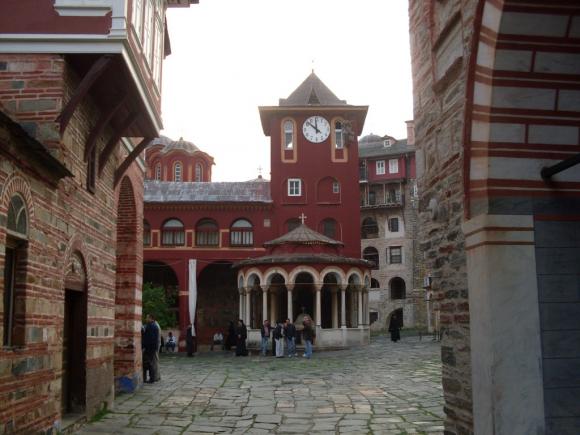

St. Sava and Simeon
Next day, we continued toward Esphigmenou monastery. Our plan was to visit Zograf and Chilandar and to overnight at Esphigmenou. At the gate of Vatopedi, we met two monks from Zograf, George and Parthenius. We continued together, toward Zograf. We talked about relations between Serbs and Bulgarians, how we are all Orthodox brothers, etc. It was a very pleasant conversation. At one point, the monks stopped and began to turn around and talk something, that I did not understand. I realized that we were so wrapped up in the story, that we went in completely wrong direction! We relied on monks, believing that they know the way. At their suggestion, we walked the forest trail. The plan was to come on the other side of the hill, to the monastery of Konstamonitou. As experienced mountaineers, we realized that this is not a path, but a forest trail, which is used for cutting the woods. We were right; the trail vanished in the woods. Unfortunately, that day was the day of the Holy Cross, so monks did not eat and drink anything, from morning till evening, and the temperature was around 35 ºC! At our insistence, to take a little bit of water, they said no! We suggested to go back, to Vatopedi, but they did not want to do that. They began with a prayer and moved on, through the dense forest! It was ridiculous to go any further, so we decided to go back. But, how can we leave our Orthodox brothers? We tried, one more time, to convince them, but father George, just said: “Do not worry about us, just go on, Mother of God will help us”. Our faith was not strong enough, so we went our way, with a dread in our hearts, because we left them in the wilderness. We returned to Vatopedi, saw where we made a wrong turn, and headed toward Esphigmenou. Along the way, a demon was putting a badly thoughts in our heads, like “yes, Bulgarians are our brothers, look where they took us’’, etc. But God sees everything and miracles happens at Holy Mountain, if you have faith and a pure heart. We experienced this only a day later. Anyway, that day we, unexpectedly, walked for 40 km! Lucky for us, the road was, more or less, straight! Tired and nervous, finally we arrive at Esphigmenou.
Esphigmenou is a zealot monastery. Zealots considers themselves as a true Orthodox Christians, the last bastion of the original orthodoxy. Because of flirting with Rome, zealots no longer mentions the Patriarch of Constantinople, in their prayers, which caused a serious conflict of these two sides. The Greek Patriarch of Constantinople, in cooperation with the Minister of Foreign Affairs of Greece, sent the police, to expel monks from the monastery and the Holy Mountain. They even threw anathema on them! Several monks were arrested and convicted. Thank God, they did not fully succeed, to evict them. Esphigmenou has no electricity or any kind of help from the Greek government, like other monasteries. They are getting food and supplies in various ways. They are very hospitable and helpful and will ALWAYS offer you accommodation. Many think that the zealots are extremists, fundamentalists, but the truth is quite different. “Orthodoxy or death,” the sign on the outside walls of the monastery, is not a threatening message. It means that they are willing to die for their faith. Currently, there are four Serbian monks. I am always glad when I talk to the Serbian monk, Simeon. This time, he told us that the crisis in Greece is the sign of the arrival of the Antichrist. Monasticism that I imagined, I found at Esphigmenou. When Chilandar was on fire, at 2004, zealots were the first who helped.
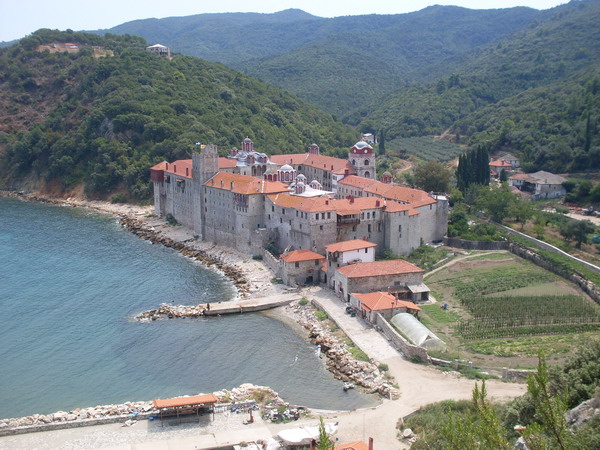
Esphigmenou
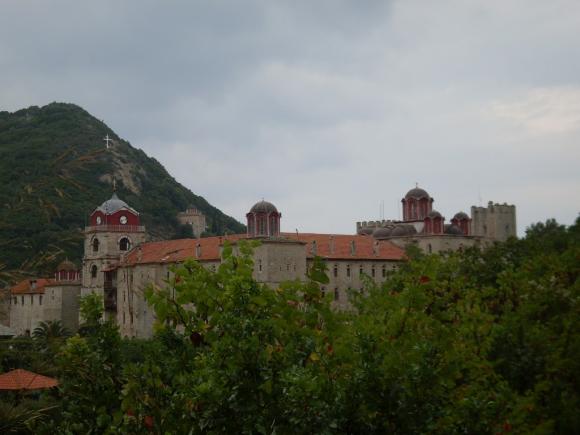
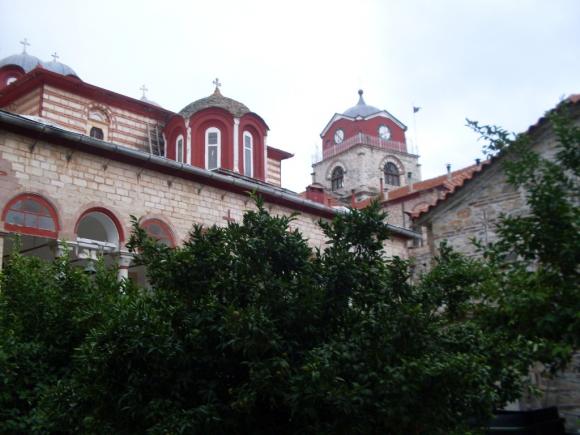
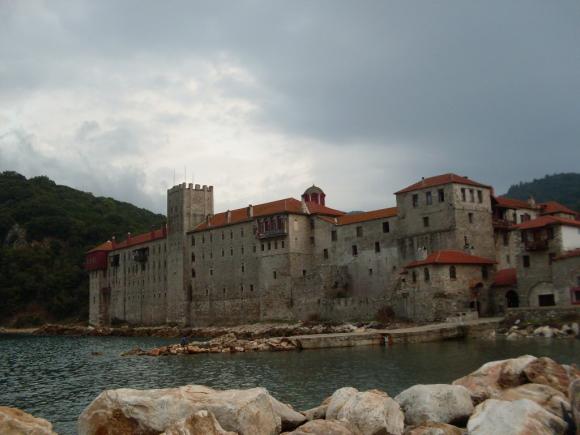
We overnight at Esphigmenou and, tomorrow, we continued to the Serbian monastery, Chilandar. We reach the largest Serbian sanctity after 45 minutes. Along the way, we pass the olive, that was planted by Serbian tsar Dusan, 700 hundred years ago. We also pass near the place where Dusans army met the monks of Chilandar.
We knew so much about Chilandar, but it is a completely different feeling, when you stay there and talk on Serbian language and understand the service, at the church. Every Serb should visit Chilandar, at least once in his life and venerate the miraculous icon “The Mother of God of Three Hands”.
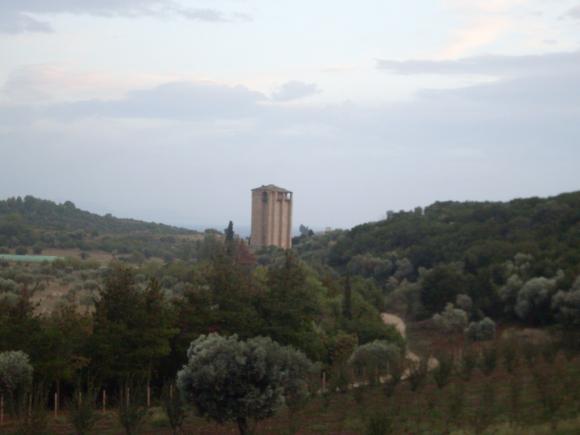
Tower of king Milutin
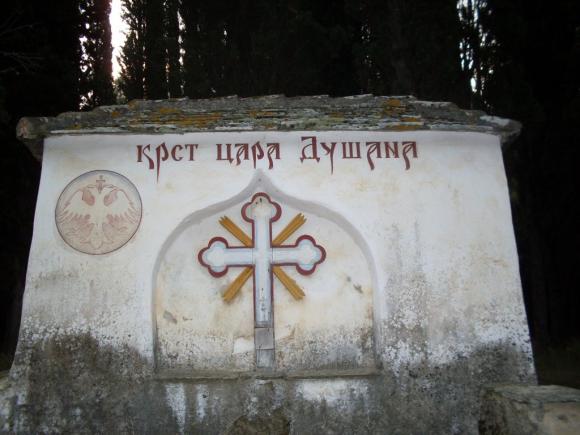
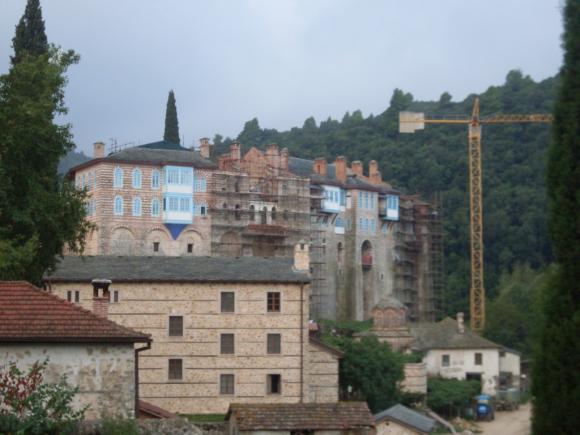
Chilandar
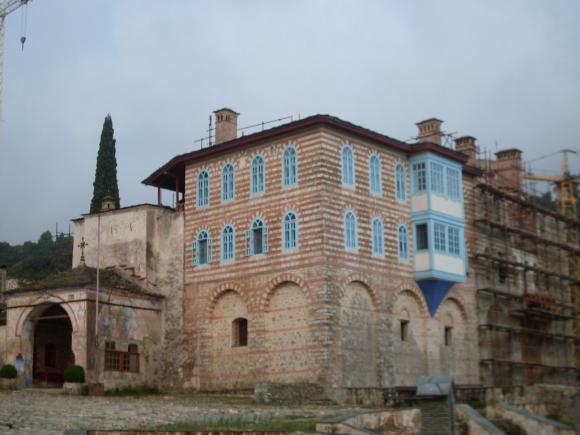
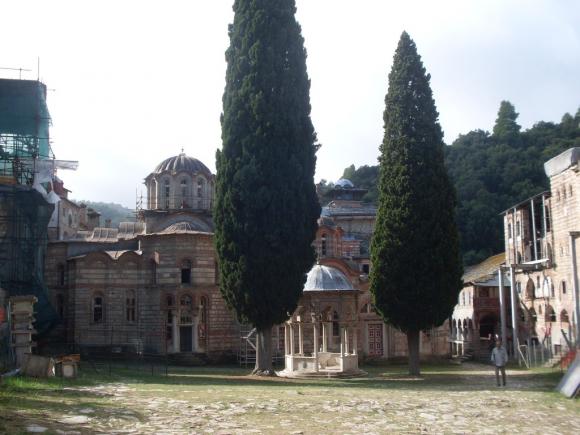
Church of king Milutin
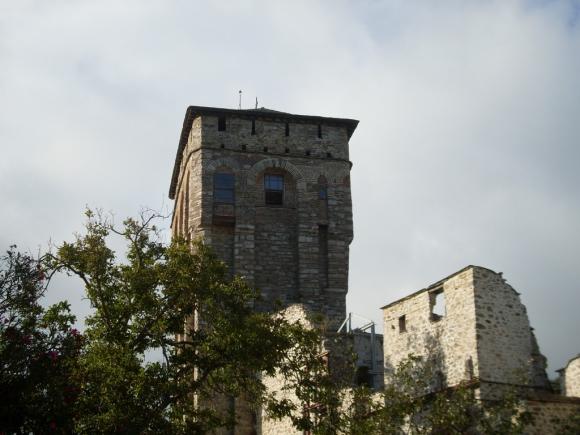
Tower of St. Sava
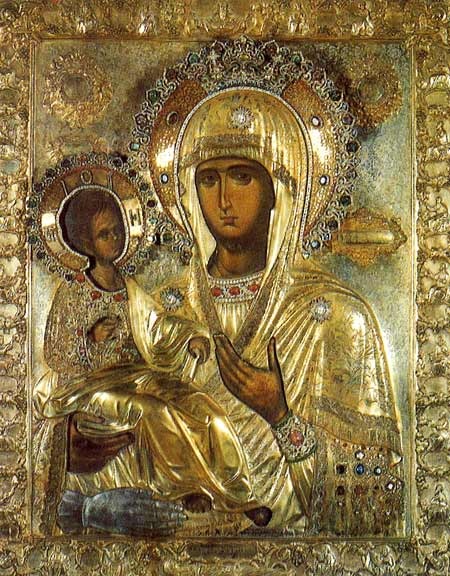
Chilandar was supposed to be our last stop on Holy Mountain, but God had other plans. He sent a storm, so we extended our stay for another day. We used that day to visit several other monasteries. Van took us to the intersection for Zograf monastery. On the way to Zograf, we visited the cave of St. Cosmas.
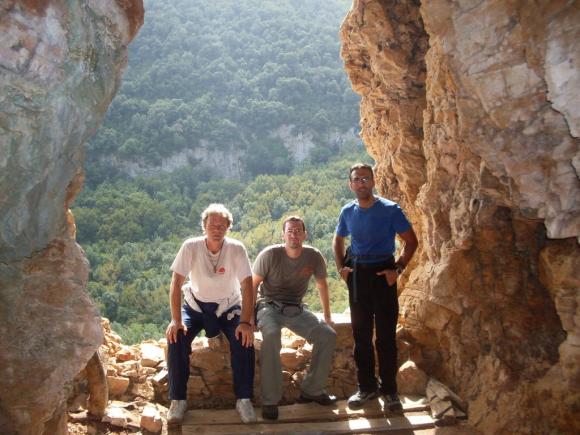
Cave of St. Cosmas
Soon, we arrived at the monastery. At monastery church, dedicated to St. George, is ‘‘not made with hands‘‘ icon of St. George. According to tradition, this icon “flew” from Syria.
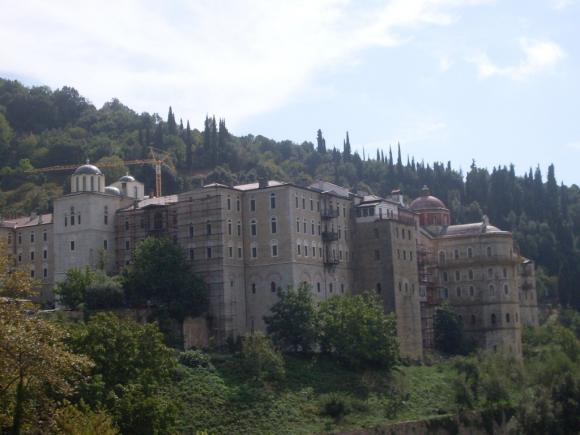
Monastery Zograf
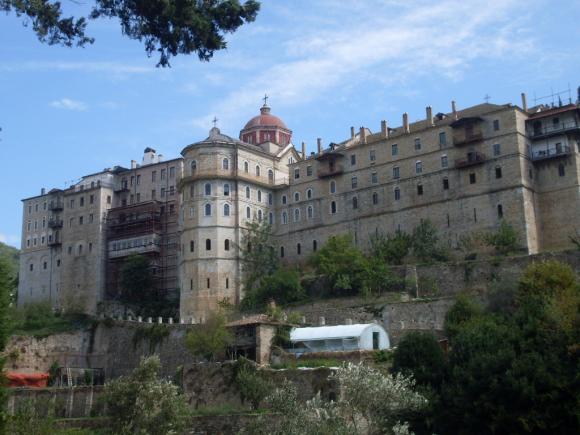
We went to the guest house and saw – father George! We were so glad that he is OK! His obedience is to be the guestmaster. He told us how they get out of the woods. Father Parthenius, as a younger monk, had to make the way through the woods. They get out of the woods at 19:00. They spent the night at Konstamonitou monastery. When we asked where Parthenius is, he said that he is resting. Parthenius was tired, because he had to cut the way through the woods. I felt relieved, anxiety was gone! That’s how our faith was weak! We marched for many miles, we are in full training, but these two ascetic monks gave us a good lesson, in faith! Of course, father George let us stay for the night. Since that day was the day of the Holy Cross, monastery gate was open all night. That gave us more time, so we visit three more monasteries. We hiked the main road, towards Konstamonitou. After an hour and a half, we arrived at the monastery. The monks were resting in their cells, after the vigil, so we could not enter into the church.
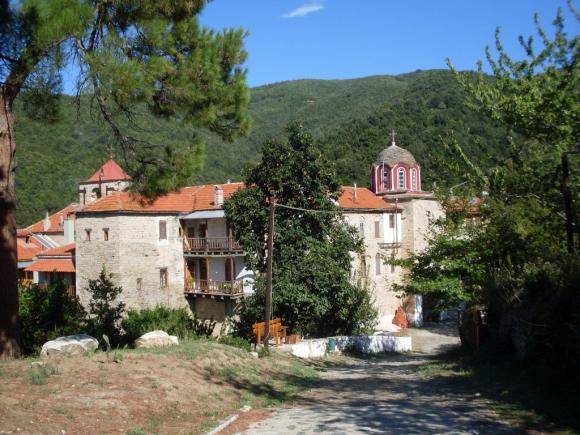
Konstamonitou
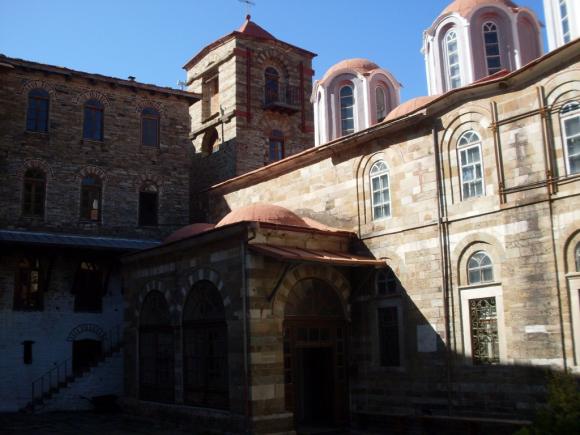
Next stop is monastery Dochiariou. It is located on the coast. It took us about an hour and a half, to reach it.
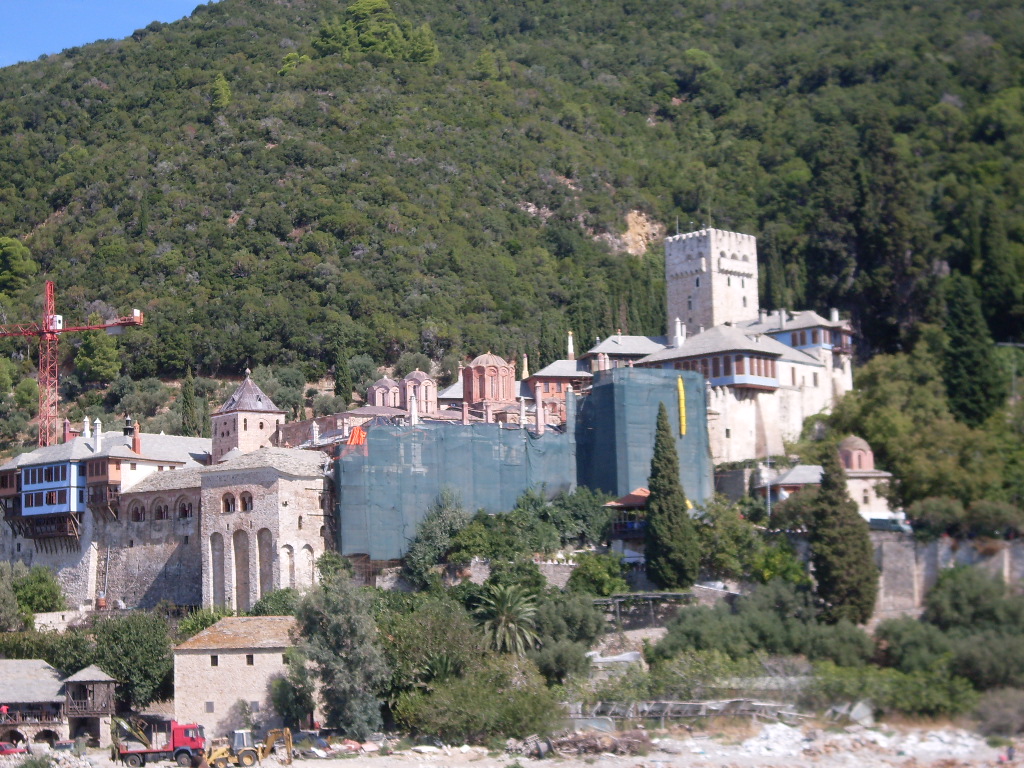
Dochiariou
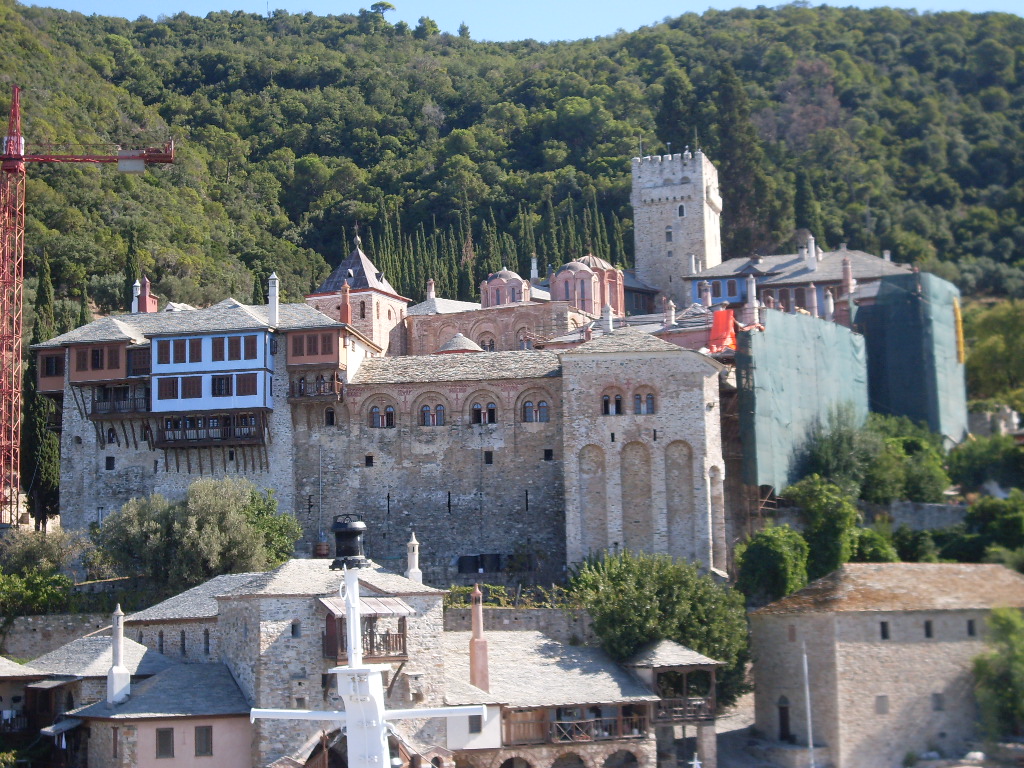
We tried to find someone, to open the church, or someone who speaks English. We already lost our hope, when we heard: “Brothers!” It was the monastery cook, Serb Mihajlo, from the town of Sevojno. A smile spread across our faces, because we found ‘‘our man‘‘ here. Mihajlo took us to the church and quickly showed us the icons. We got holy oil, as a gift. We were short with time, and we thought to skip a visit to a nearby Xenophon, but our doubts was interrupted by Mihajlo: ‘‘Go, Mother of God is with you, she’ll help you! ” Strengthened in faith, we went to Xenophon. Actually, we ran to the monastery! After 15 minutes, we arrived at the monastery, whose interior is very similar to Vatopedi.
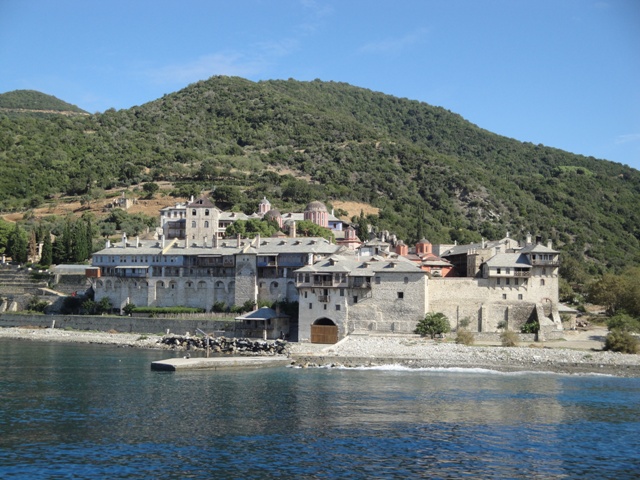
Monastery Xenophon
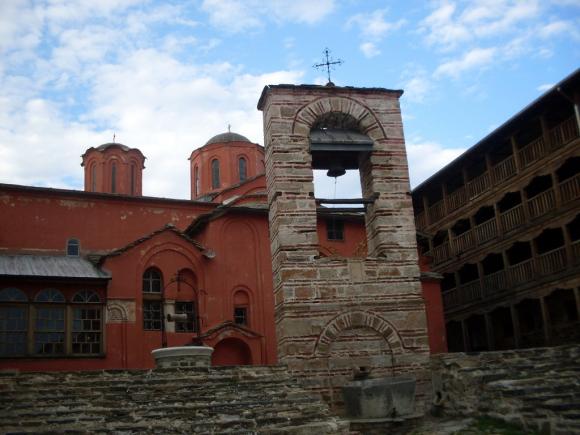
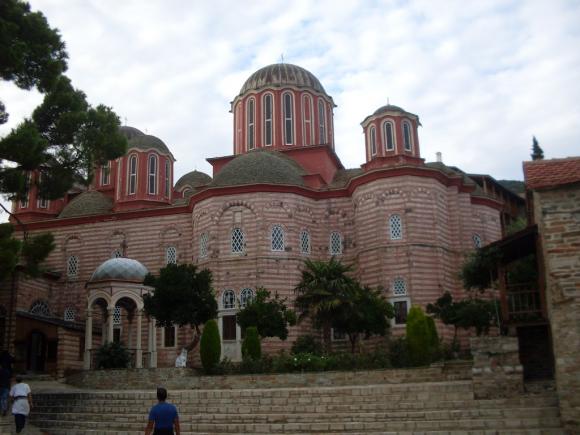
We walked along the shore, for more than an hour and a half, and came to Zograf in the evening. Dinner was over, but, on our request, a monk opened the dining room. We were so hungry, that we ate several portions of food! We decided to repay hospitality, so we washed all the dishes. It was an interesting experience, working in the ancient kitchen. We done our job very well, so father Paul, a head cook, jokingly invited us to stay as monks.
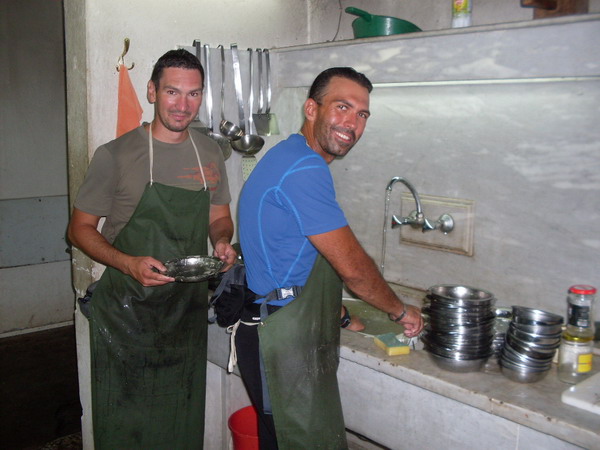
The day of departure has arrived. We summarized our impressions. We walked for 6 days, hiked about 130 km, climbed Athos in one day (overcomed the total difference in altitude of 4066 m ), visited two sketes and 17 monasteries (of possible 20); all of that at the hot September sun. All the time, we had some extra energy and power, that pushed us forward. It looks like, seeing our desire and effort, God and the Holy Mother helped.
We reached Zograf port in 45 minutes. We boarded at ferry, but in the opposite direction. We wanted to see another impressive monastery, the Russian St. Panteleimon. We had about 45 minutes for the tour. Cameras and photos are forbidden inside the monastery, but friend and I ignored that information. So, both of our cameras were damaged, when we came back to Belgrade! God’s punishment!
The monastery owns the second largest bell in the world. The biggest one is at Kremlin. From mid 14th century, monastery was Serbian, for next 150 years.
At the entrance of the monastery is a large photo of the monks. Photo was made in 1903, while the monks were provided the charity. At the left corner of the photo, you will see the Mother of God, caught by a camera! Another miracle!

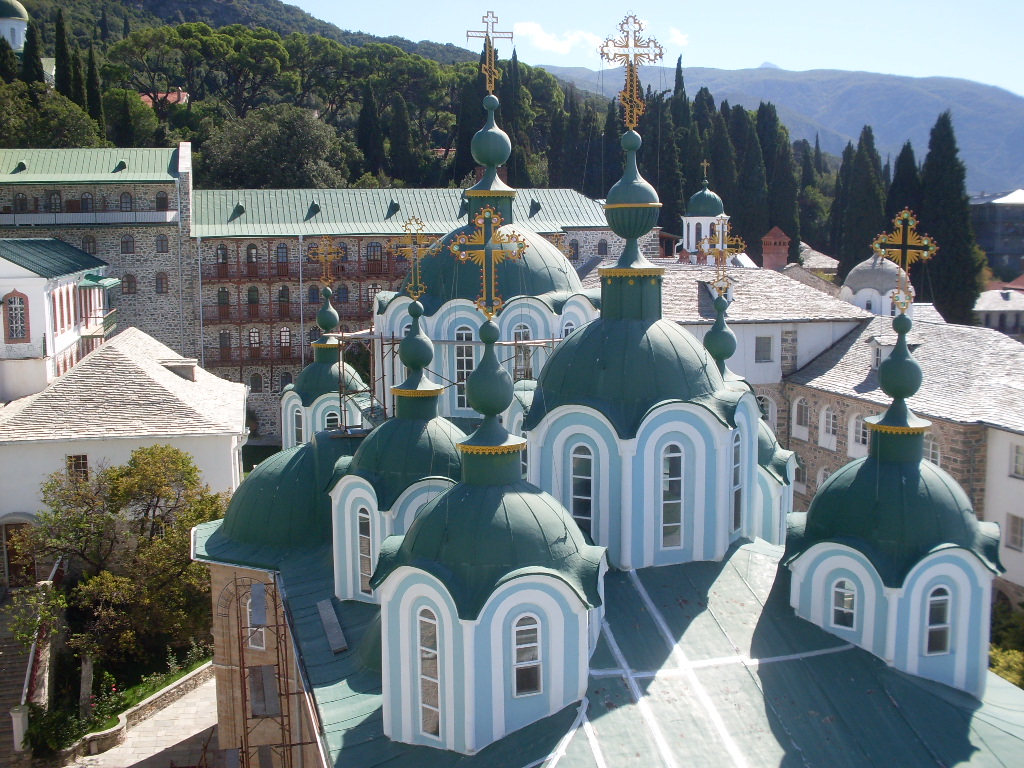
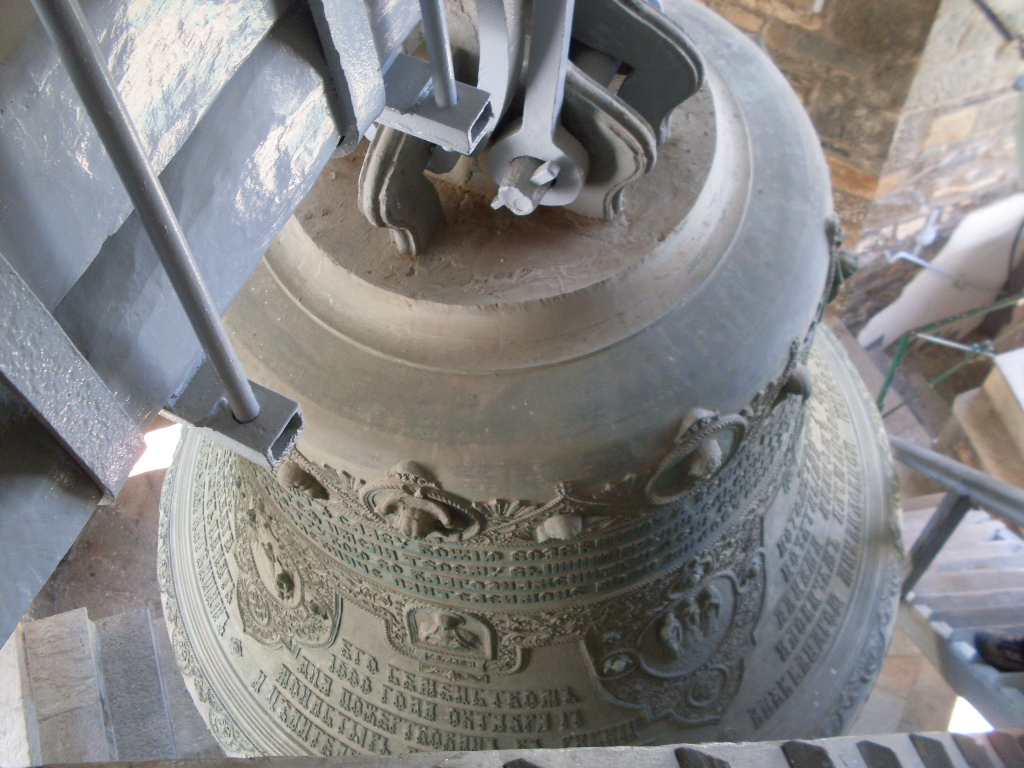
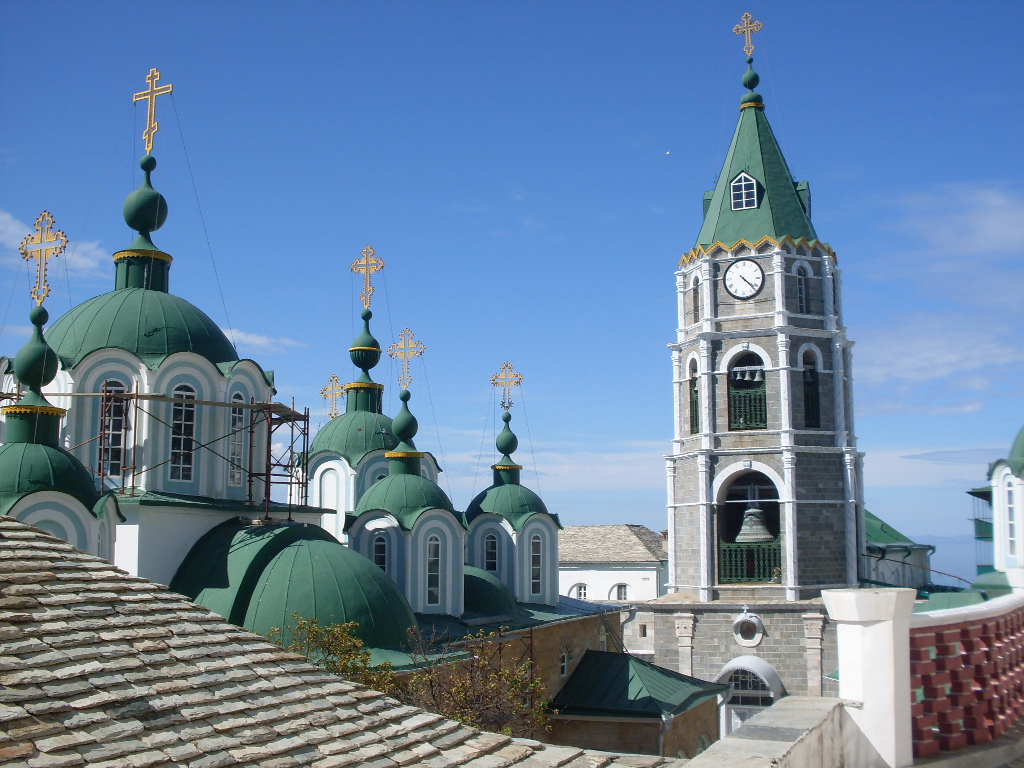
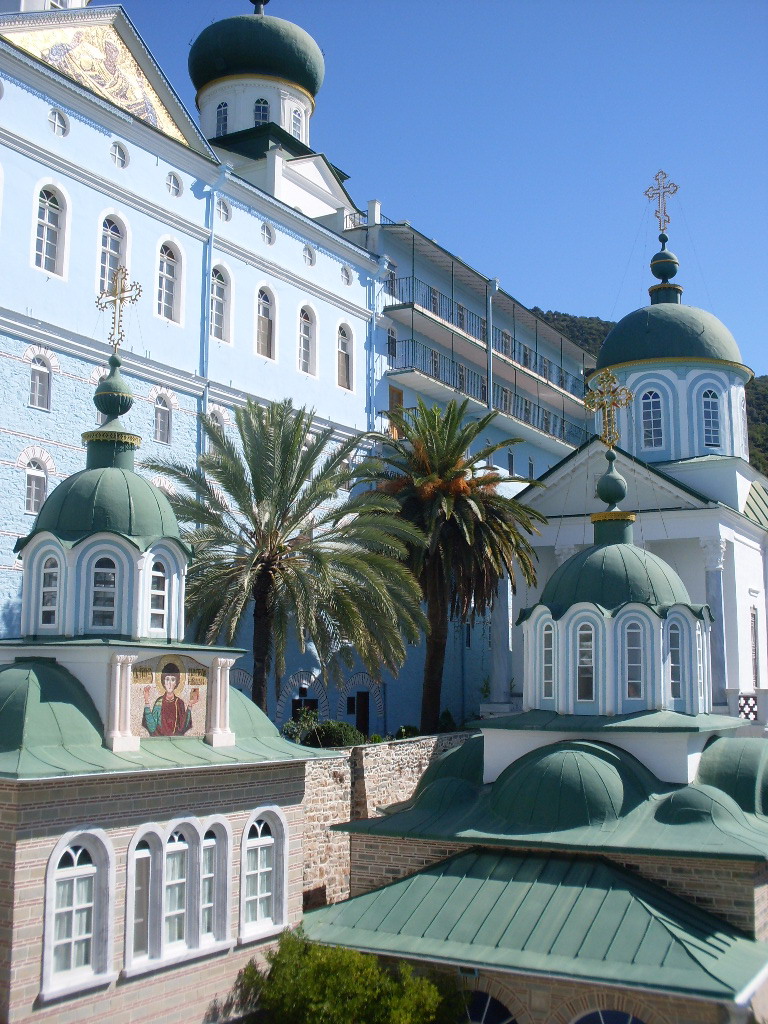
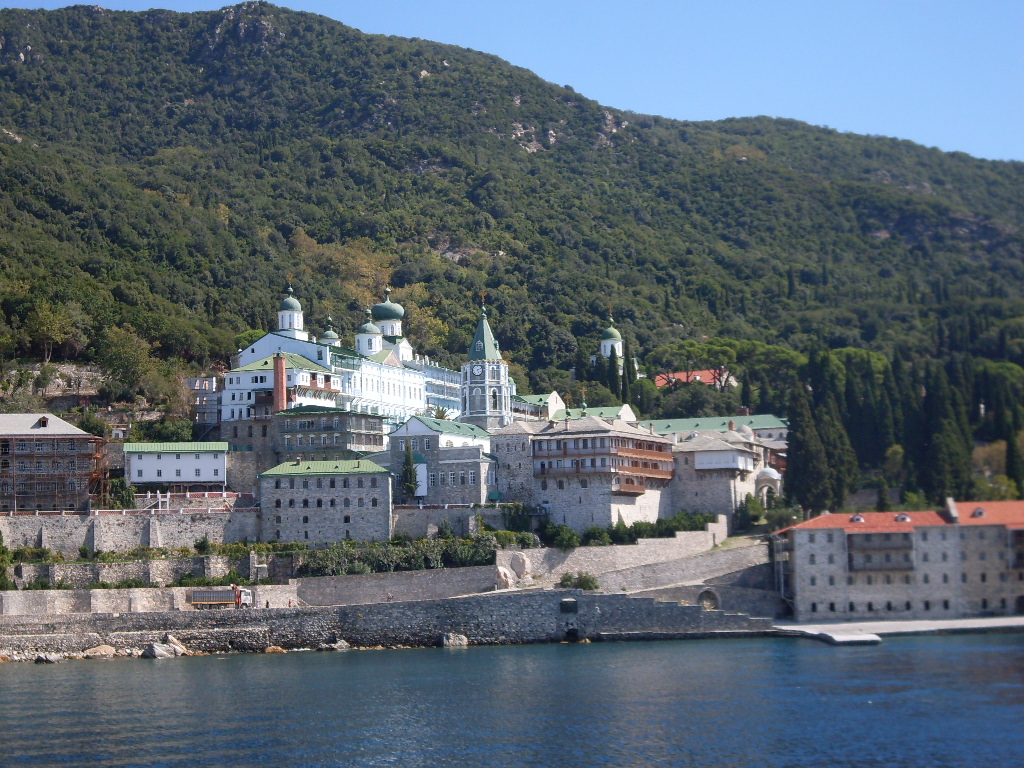
St. Panteleimon
A ferry returns us to Ouranopoli. Mount Athos is an unforgettable experience. Once you see it, you will return again. The man returns full of charity and love, relieved of all worries that burdens him. Many answers can be found, at this holy place. The monks who live in modest cells and wear torn clothes, are happier than most people I know in the world. We do not need much to be happy, but we are not aware of it. In our world, we have everything, but we are not satisfied. That‘s why is good to be back at this holy place; to renew spirituality and to strength faith.
September 2010.
No responses to “MOUNT ATHOS (Athos 2033 m)”
Leave a Reply
You must be logged in to post a comment.

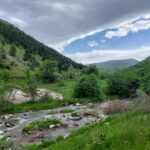
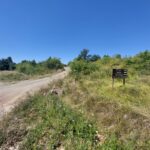
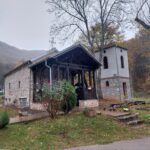
 Srbija na dlanu
Srbija na dlanu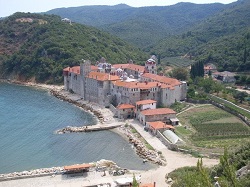 SVETOGORSKE TURE
SVETOGORSKE TURE Moja planeta
Moja planeta Vila Ćetković
Vila Ćetković Jooble
Jooble Outdoor Srbija
Outdoor Srbija
Saint Mount Athos- marvellous.
Prelepo! Bio sam vise puta, ali sam dosta saznao i od vas sada. Hvala na ovako divnom putopisu.